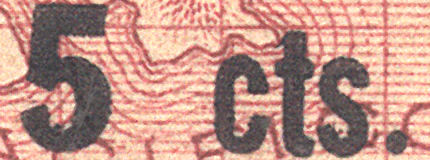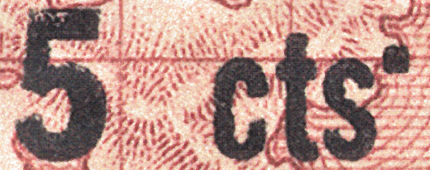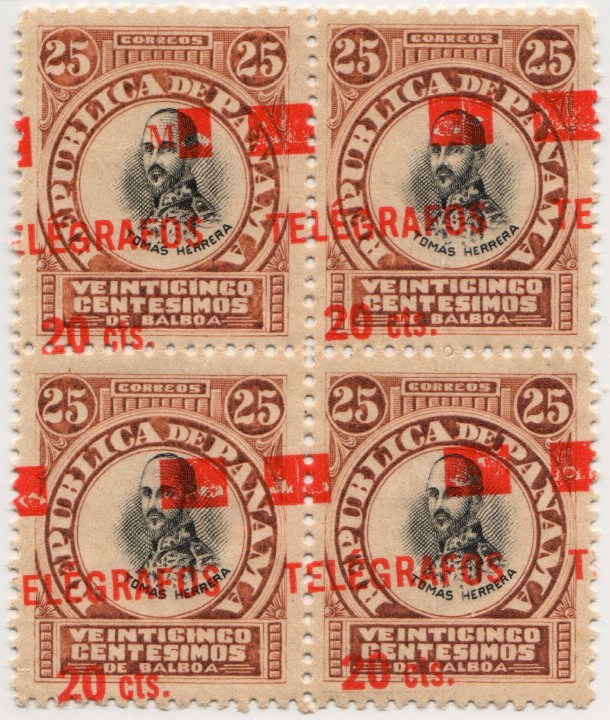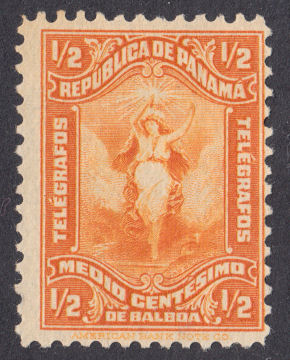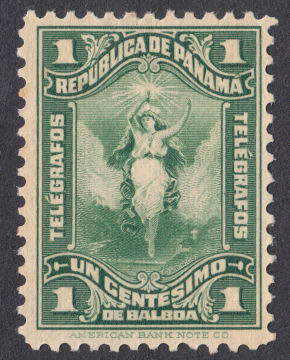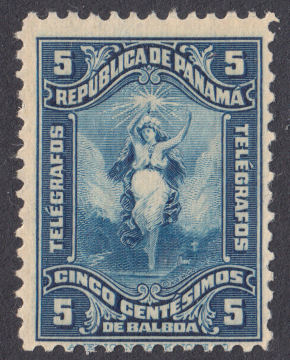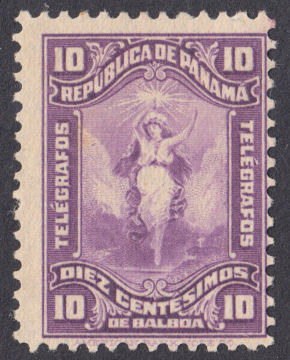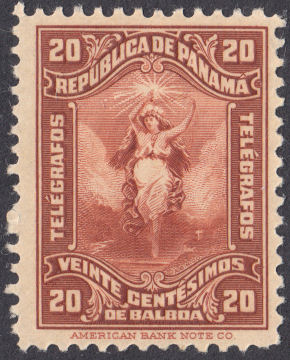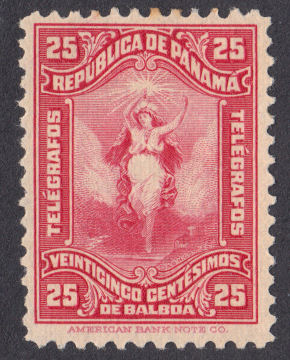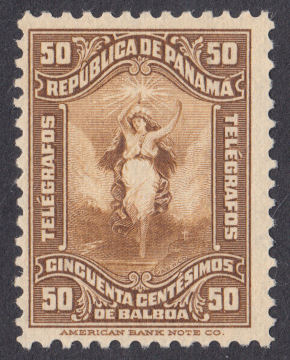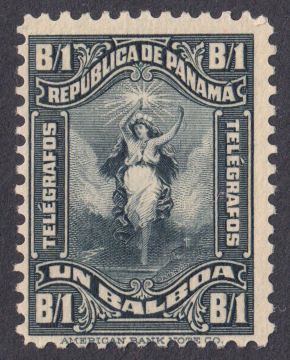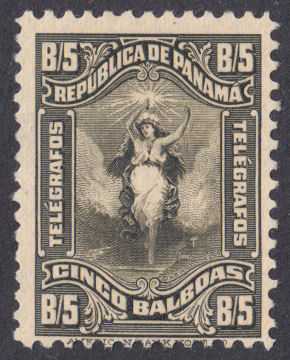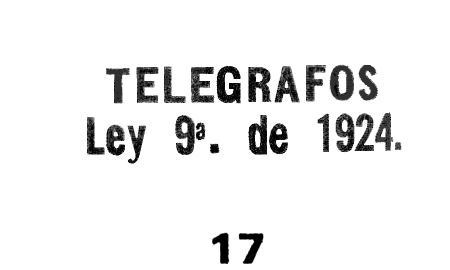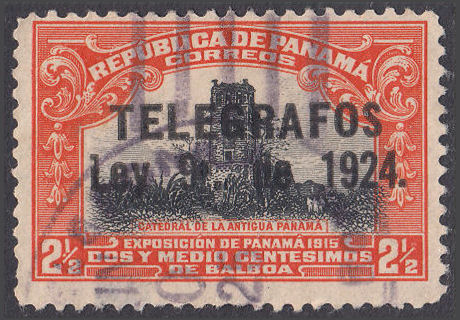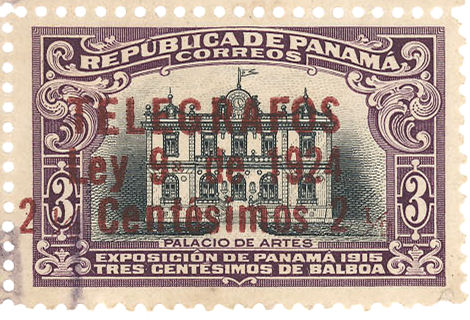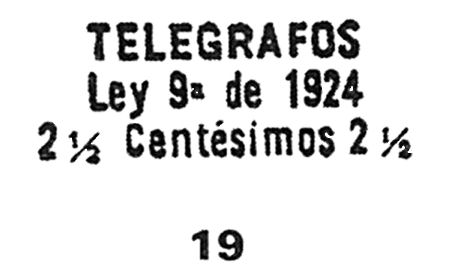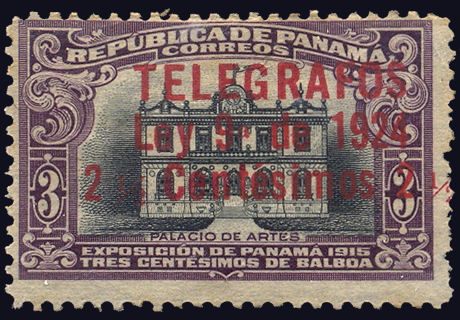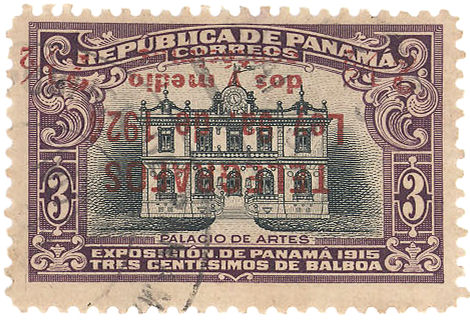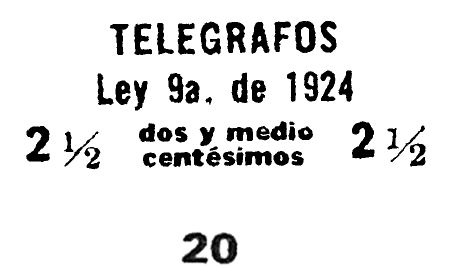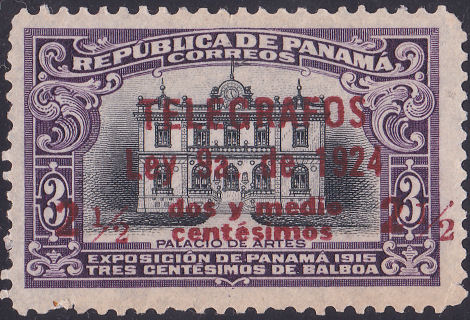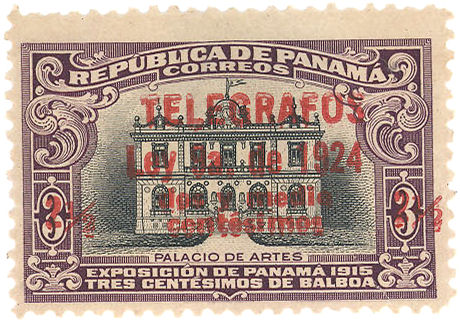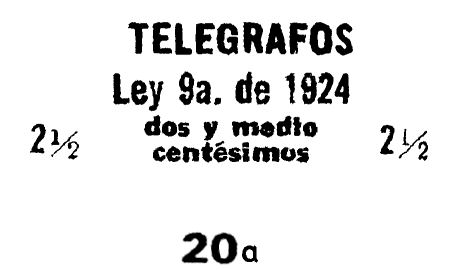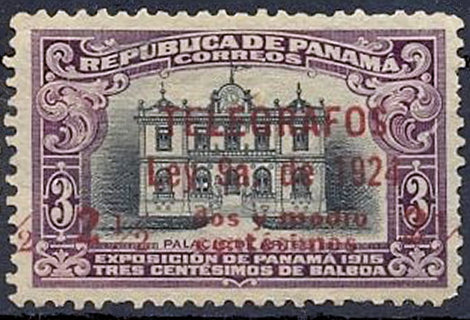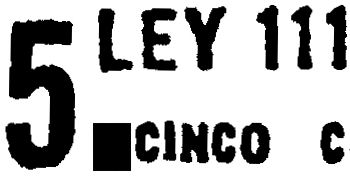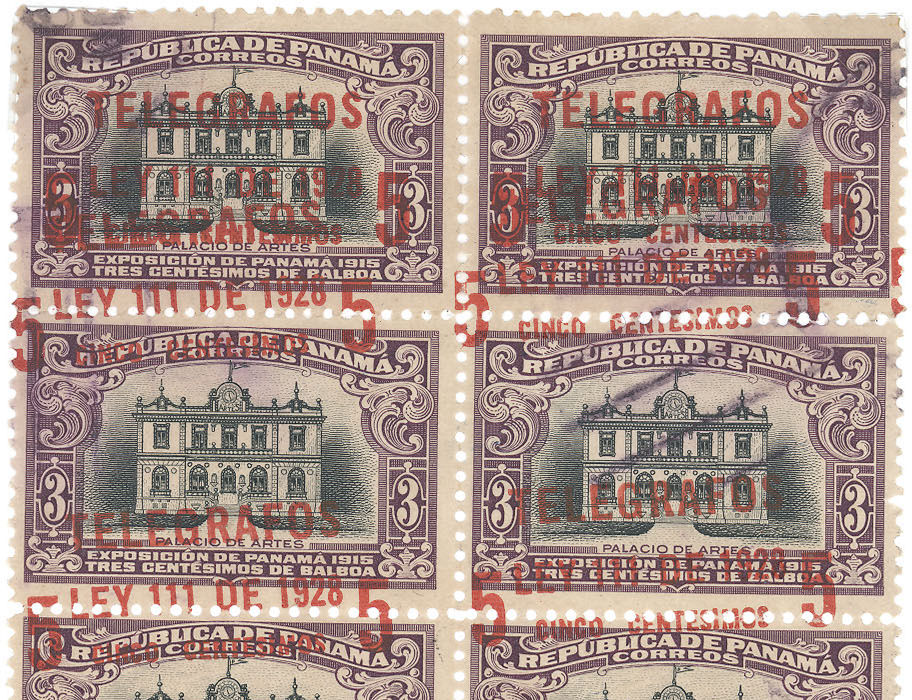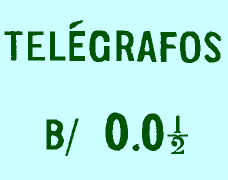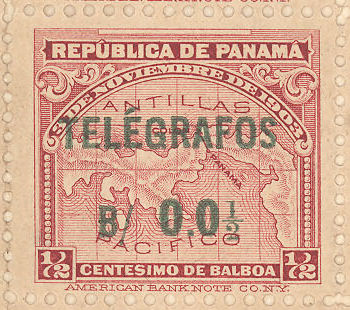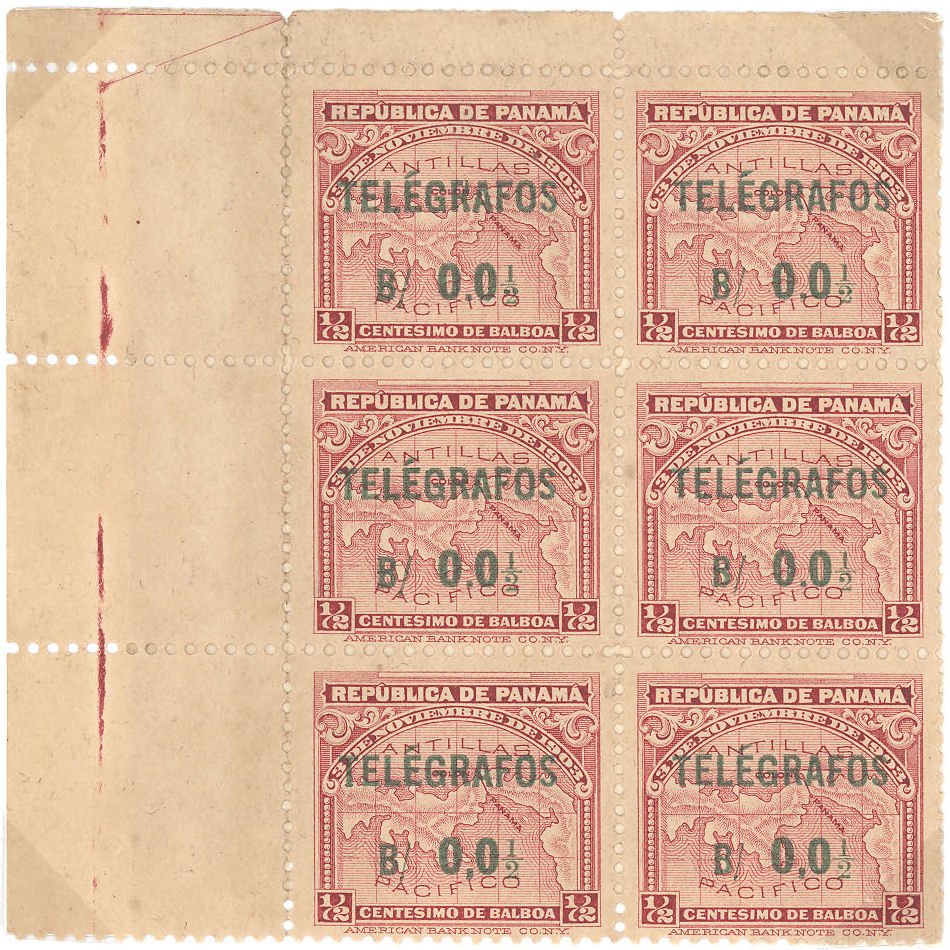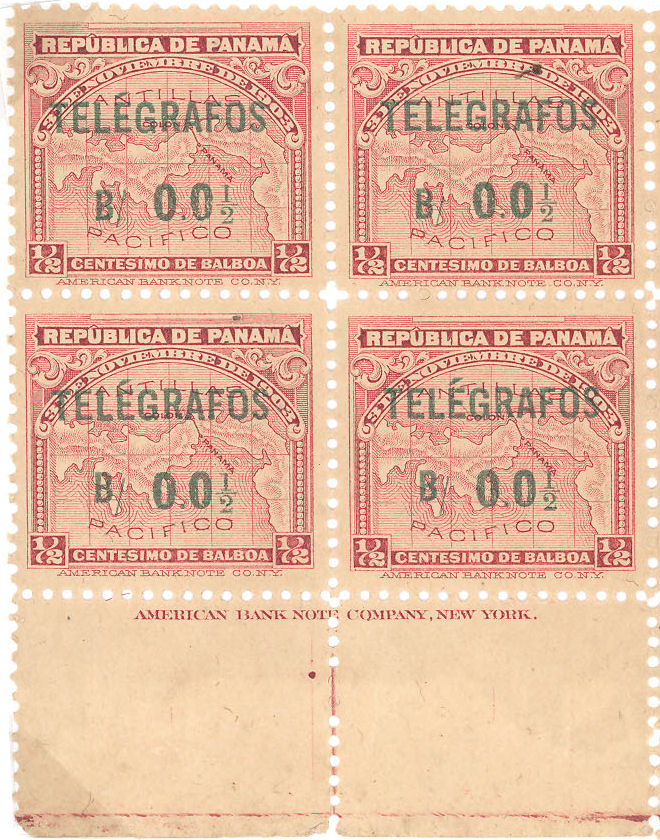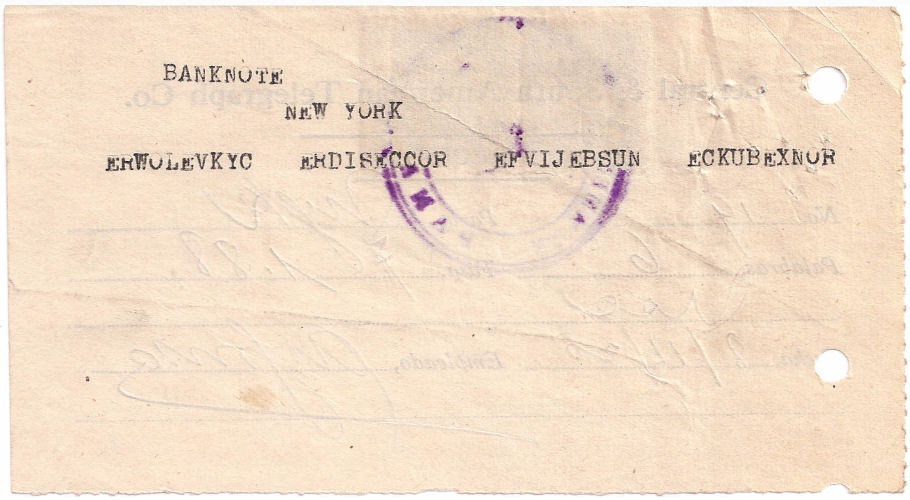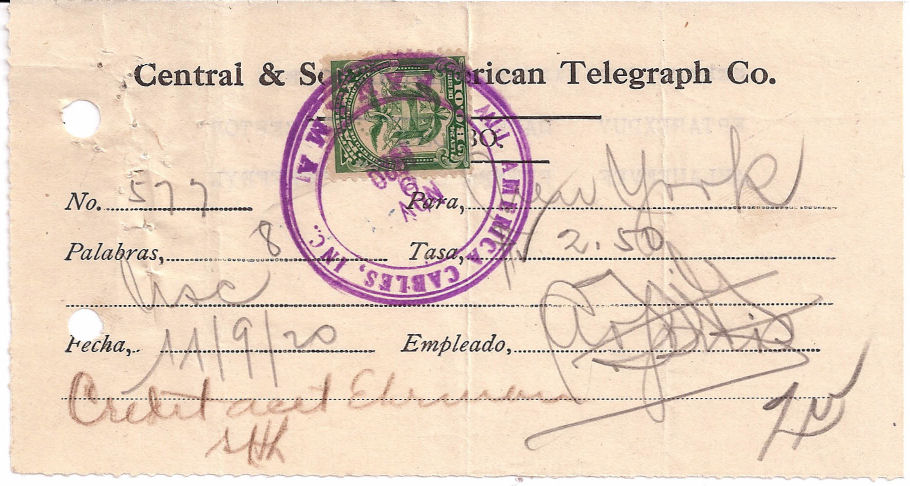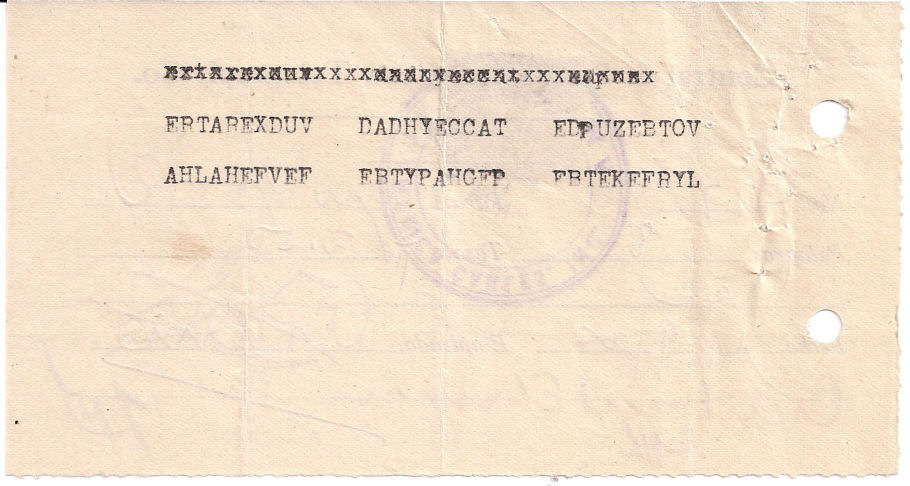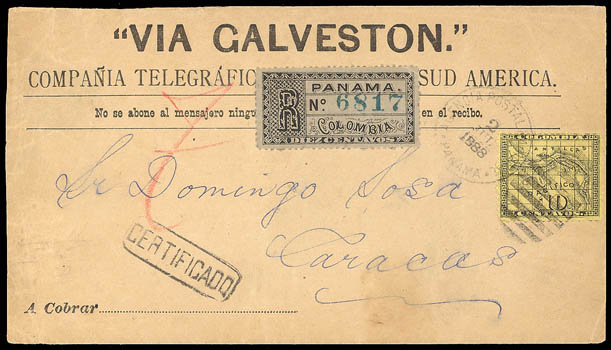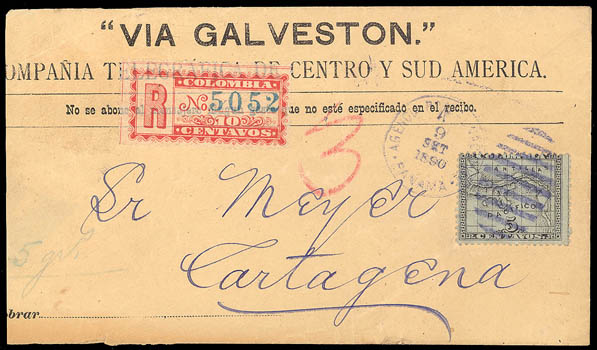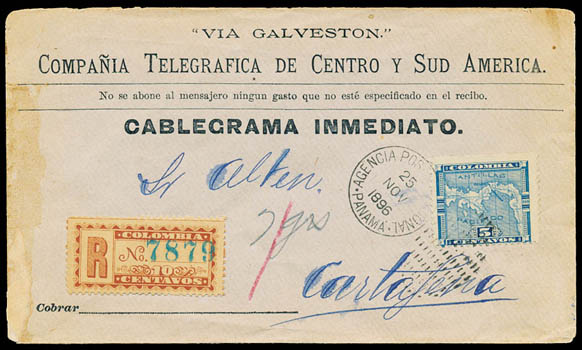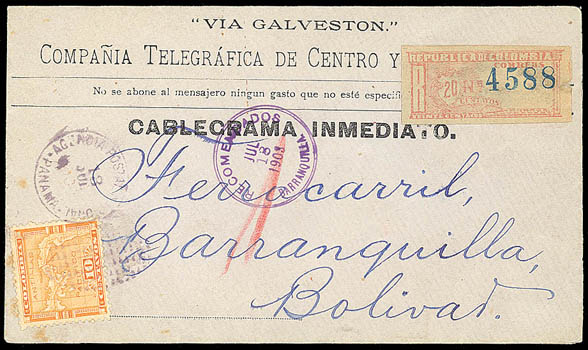| Up a level | ||||||||||
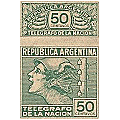 |
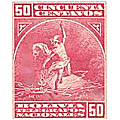 |
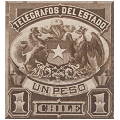 |
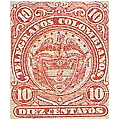 |
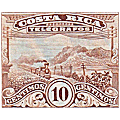 |
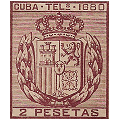 |
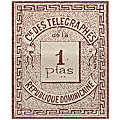 |
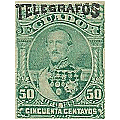 |
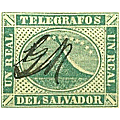 |
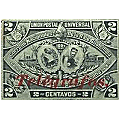 |
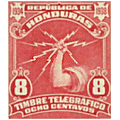 |
| Argentina | Bolivia | Chile | Colombia | Costa Rica | Cuba | Dominican Rep. | Ecuador | El Salvador | Guatemala | Honduras |
| Up a level | ||||||||||
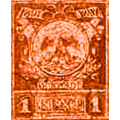 |
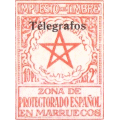 |
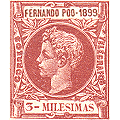 |
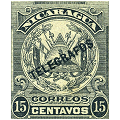 |
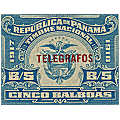 |
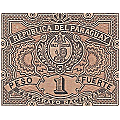 |
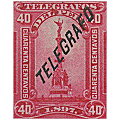 |
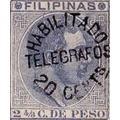 |
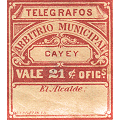 |
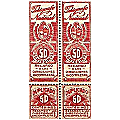 |
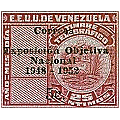 |
| Mexico | Morocco | Guinea | Nicaragua | Panama | Paraguay | Peru | Philippines | Puerto Rico | Uruguay | Venezuela |
I have revised Hiscocks' original listing, though leaving references to the original designations. This is largely to accommodate additions. I have brought the prices up to date and added currency selection. The new designations have 'RH' numbers (Revised Hiscocks) to avoid confusion. CheckList Setup |
Panama.
Steve Hiscocks wrote:
At the time of the first specifically Panamanian telegraph stamps in 1892 the country was under the control of Colombia and the fist issue, inscribed
'Republic of Colombia, Department of Panama', are typical of Colombian designs. They are often listed under Colombia but inclusion under Panama
seems more appropriate. Panama became independent in 1903 but it was not until 1917 that telegraph stamps were introduced, first by overprinting
various old postage issues and then in 1919 by the issue of specific telegraph stamps. Such efficiency was unfortunately short-lived and the issue of
overprinted postage stamps continued from 1924 to 1935. Presumably postage stamps were used without overprints between 1903 and 1917 and after 1935.
My note:
I would like to thank Federico Brid and Joe Ross, authors of the Panama Telegraph Stamp Catalog in 2000
who have kindly allowed me to use images from it on this web-page. A few needed to be added.
Since many people still use that catalogue, I have added a cross-reference column labelled BR#.
Federico says :
"For years I have been mounting specialized sections of my collection of Panama stamps. Mainly they are collections that have proof and error material which I considered difficult to obtain.
I call these montages VIRTUAL INVENTORIES. My intention is to record what exists for eventually dealers will get a hold of them and scatter them all over the place.
I mount it and then scanned it. So far I have over 2,000 pages of this type of mountings. Some are mounted in English and others are in Spanish and some on regular pages and some on 11x 17 pages."
It seems to me that these would be of interest to collectors, so here is one for starters :
I have tried to show it as it was about 1918.
By 1912 there were a number of Wireless Telegraph Offices along the North Coast, Boca del Toro and Colón (Commercial); Colón and Portobello (U.S. Navy), as well as numerous ships/boats.
Article 44 of decree 115 of 14 July 1917 listed fees for 3 minutes of long distance telephone calls between 27 places. Assuming that the stations
mentioned were using the same lines as the telegraph network, I have mapped those stations. Alphebetically they were:
Aguadulce, Antón, Capira, Chame, Chepo, Chitré, Chorrera, Colón, David, Divisa, Horconcitos, La Mesa, Las Palmas,
Las Tablas, Los Santos, Natá, Ocú, Pacora, Panamá, Parita, Penonomé, Pesé, Remedios, San Carlos, Santiago, Soná, Tolé.
Decree 8 of 9 July 1919 ordained: The Telegraph System in the Republic will be divided into six designated sections in order to facilitate supervision and inspection. The following is a list of the cities and towns in each section.
Sole Article. Within the territory of the Republic the telegraph service, will be divided into six sections effective July 1 of this year and in the following manner:
1st Section.
The telegraphic and telephone offices of Arraiján, Bejuco, Campana, Capira, Capitana, Cermeño, Colón, Chame, Chorrera, Nueva Gorgona, Pacora, Paja, Panamá, Portobelo, Potrero, Pueblo Nuevo, Puerto Caimito, Puerto Capira, San Carlos and
other offices that may be established within the territorial circuit of the Province of Panama and as far as the telegraph pole of the Antón office.
2nd Section.
The telegraphic and telephone offices of: Aguadulce, Antón, Cristo, Estero Salado, Jagüito, Llano Sánchez, Natá, Olá, Penonomé, Pintada, Pocrí, Puerto Aguadulce, Puerto Obaldía, Puerto Posada, Rio Hato, Rio Grande and
from Santa Rosa to the telegraph pole of the Santiago office and all those new offices that may be established within the territory of the Province of Coclé
3rd Section.
The telegraphic and telephone offices of Arena, Chitré, Chupampa, Divisa, Guararé, Las Minas, La Palma, La Teta o Santa Domingo, Las Tablas, Los Santos, Los Pozos, Macaracas, Mariabé, Mensabé, Monagrillo, Ocú, Parita, Paritilla, Pedasí,
Pocrí, Puerto Chitré, Puerto Guararé, Punta Mala, Sabanagrande, Santamaría and all new offices that may be established within the territory of the Provinces of Los Santos and Herrera.
4th Section.
The telegraphic and telephone offices of Atalaya, Barranco-Colorado, Calobre, Cañazas, La Mesa, Las Palmas, Montijo, Ponuga, Puerto Mutis, Rio de Jesús, San Francisco, Santa Fé, Santiago, Soná and
all those new offices that may be established within the territory of the Province of Veraguas.
5th Section.
The telegraphic and telephone offices of Bocachica, Horconcitos, Las Lajas, Remedios, San Félix, Tolé, and up to the telegraph pole of the Las Palmas office and
all those new offices that may be established within the mentioned districts.
6th Section.
The telegraphic and telephone offices of Alenje, Boquete, Boquerón, Chiriquí Viejo, Conceptión, David, Divalá, Dolega, Gualaca, Lino and Pedregal from the telegraph pole of the office of Horconcitos including
those new offices that may be established within the mentioned districts.
Given in Panama, on the 11th day of the month of July of one thousand nine hundred and nineteen.
Belisario Porras
The Secretary of Government and Justice,
R. J. Alfaro
(Translation from the original Spanish courtesy of Federico Brid)
Panama under Colombian control.
1892 On coloured wove paper. No watermark. Perf. 12.
Suspected printed by the Demitrio Paredes printing company, Bogota.
Hiscocks type 1.
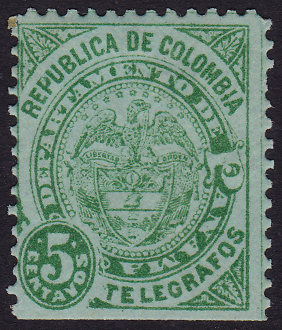 |
 |
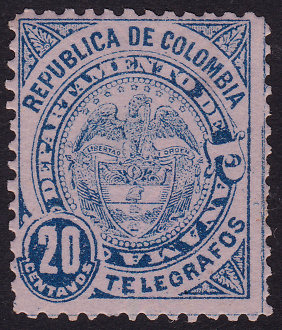 |
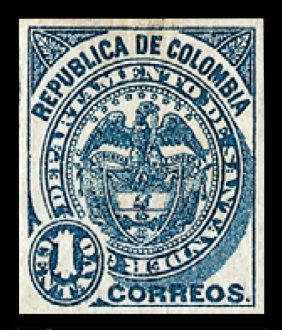 |
| RH1 | RH2 | RH3 | Santander postage stamp, 1887 |
Click on any of these three to see complete sheets (10x5), courtesy of Federico Brid.
It has been pointed out that these are similar to the 1887 postage stamps of the Department of Santander, Colombia.
Why Panama should be the only Department to need its own Telegraph stamps rather than the normal Colombian Telegraph stamps of the time is a mystery.
There appears to be no evidence that they were ever used.
| RH # | Hisc. | BR# | Type. | Description | Mint | Used |
|---|---|---|---|---|---|---|
| RH1 | H1 | 1 | 1 | 5c green / pale bluish green | 20.00 | - |
| RH2 | H2 | 2 | 1 | 10c red / pale pinkish brown | 10.00 | - |
| RH3 | H3 | 3 | 1 | 20c blue / pale rose | 12.00 | - |
Republic of Panama.
Decree 115 of 14 July 1917 instituted the use of these stamps which were required for the transmission of telegrams.
It also instituted a long distance telephone service within Panama (Article 35). Fees for this telephone service were to be paid by the use of telegraph stamps (Article 36).
Article 37 refers to Private telephone companies that did not use the stamps. Internal telegrams required the stamps to be punched eventually (Article 8), but cablegrams did not (Article 13).
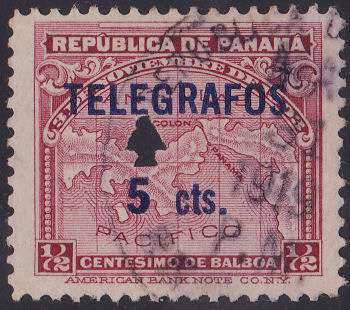
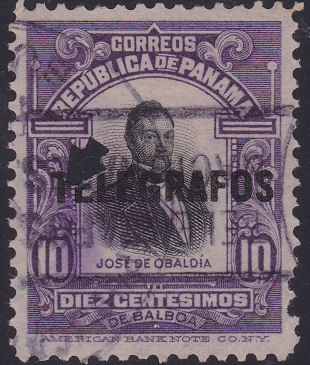
 |
 |
Used and punched examples. The 5c on 3c a round hole of about 1mm on the "M" of "PANAMA". It took me a while to even notice it. The last is courtesy of Nik Oquist of OquistStamps on eBay (click image for listing).
Not all punched stamps are telegraphic though, the last could have been fiscally used. Early sending forms with any form of stamps attatched are unknown, though receipts with fiscal stamps covering a tax on them are known.
The tariffs within Panama were stipulated in Article 44 of the decree:
10c for the first 10 words. Address and signature of sender count within the 10 words.
Each additional 10 words, or part of, cost an additional 5c.
Telegrams in code, in numbers or in a foreign language would be charged at double the rate.
Telegrams from Panamá (city) to Colón (Canal Zone) in any language, in code or in numbers were charged at 25c for the first 10 words and 2c for each additional word.
Urgent telegrams, or those requiring an acknowledgement of receipt were to be charged an additional 10c.
Article 44 also stipulated rates for 3-minutes of long distance telephone calls between 29 stations ranging from 20c to B/ 1.50
additional minutes were charged at rates depending on the 3-minute charges of 50c to B/ 1.50, in the range of 10c to 40c.
Article 46 stipulated the stamps to be used. They corresponded to RH4, RH5, RH6/13, RH7, RH11 and RH 12.
Article 47 stipulated that all this was to take effect from the first of August, abolishing anything to the contrary.
1917 Postage stamps of 1906 (SG 144, etc. Hamilton Bank Note Co.) overprinted 'TELEGRAFOS' in black (type 3).White wove paper. No watermark. Perf. 12
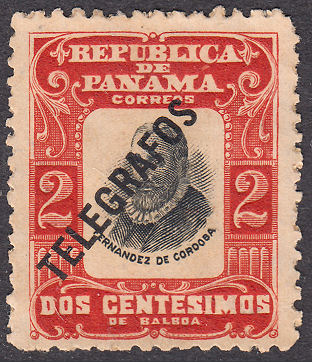 |
 |
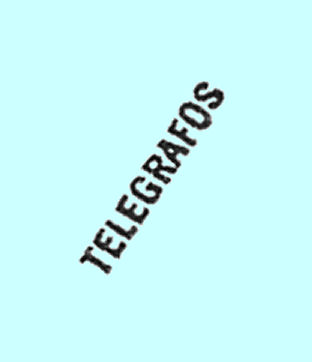 |
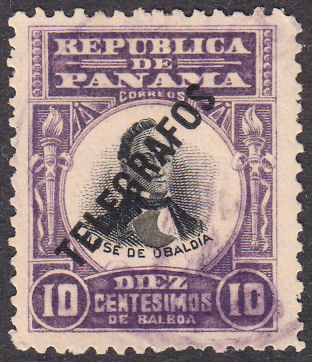 |
| Type 2, RH4 | RH4a - courtesy of Federico Brid | Type 3 | Type 4, RH5 |
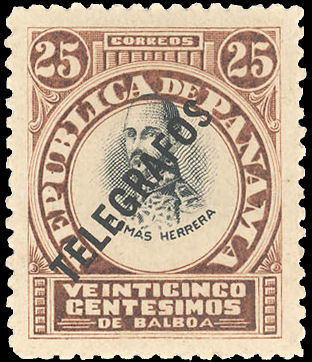 |
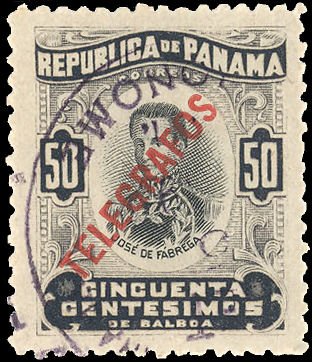 |
| Type 5, RH6 | Type 6, RH7 |
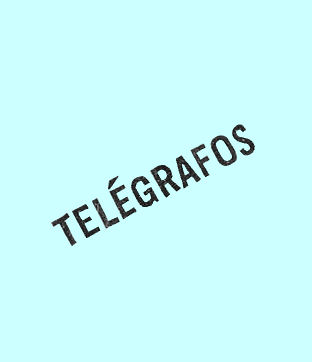 |
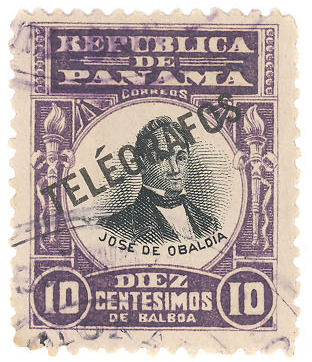 |
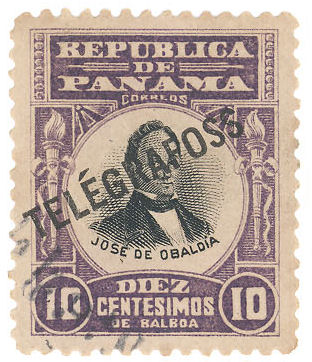 |
| Type 3A Accent on 'É' and less sloping. | *RH8 | *RH8a Double 'S' i.e. 'TELÉGRAFOSS' |
Images for RH6, RH7, RH8 and RH8a kindly supplied by Federico Brid.
| RH # | Hisc. | BR# | Type. | Description | Mint | Used |
|---|---|---|---|---|---|---|
| RH4 | H4 | 4 | (2), 3 | 2c carmine and black (SG 144) | 2.50 | 2.00 |
| RH4a | - | 4a | (4), 3 | overprint split | 3.40 | 2.70 |
| RH5 | H5 | 6 | (4), 3 | 10c violet and black (SG 148) | 2.50 | 2.00 |
| RH6 | H6 | 7 | (5), 3 | 25c brown and black (SG 149) | 3.75 | 3.00 |
| RH7 | H7 | 9 | 6, 3 | 50c black (overprint in red) (SG 150) | 5.00 | 3.75 |
| *RH8 | - | 5 | (4), 3A | 10c violet and black (SG 148) | 3.75 | 3.00 |
| *RH8a | - | 5a | (4), 3A | error 'TELEGRAFOSS' | 17.50 | 15.00 |
* I have added these.
1917 Postage stamps of 1906-11 (SG 151, etc.) overprinted as (before but horizontally) or as below in black, red, or blue.
White wove paper. No watermark. Perf. 12, sheets of 10 x 10.
Strangely the sheet imprint is sometimes, but not always above the middle two stamps at the top of the sheet, and sometimes, but not always below the middle two stamps at the bottom of the sheet.
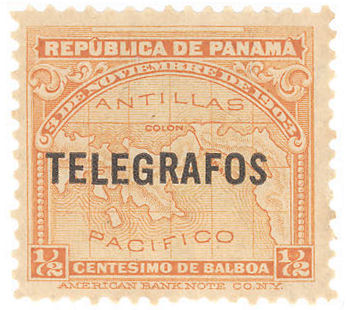 |
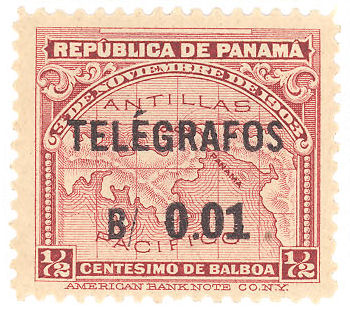 |
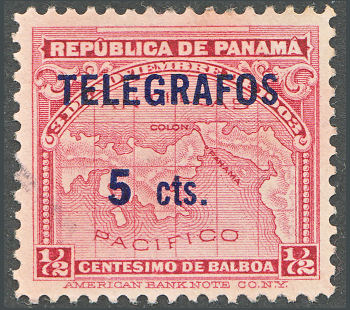 |
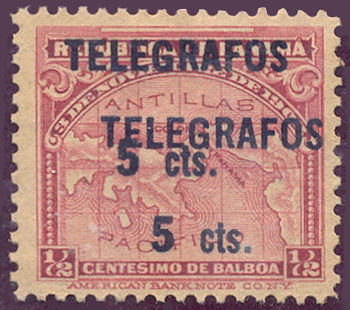 |
| RH9 No accent on 'É' | RH10 Accent on 'É' | RH11 No accent on 'É' | RH11b kindly supplied by Rolf Lamprecht |
Images of RH9, RH10, RH12a and RH13a kindly supplied by Federico Brid.
The half cent were Printed by American Bank Note Co. N.Y. in sheets of 100. The rose shade replaced the orange in 1915.
The American Bank Note Co. sheets had their imprint at the half-way point along top, bottom and sides. These can aid in positioning.
RH10a-RH10d are assumed to exist due to similarity of the overprint with RH38, but I do not have images of them.
Can anyone supply such images ?
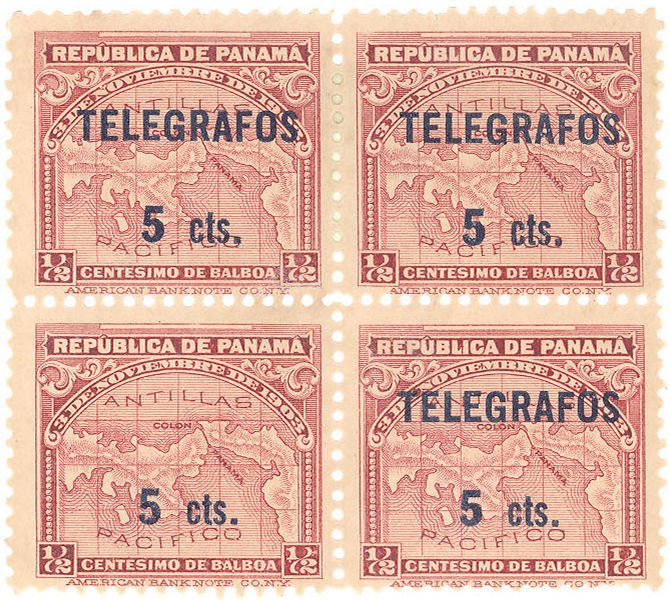

Examples of RH11g (missing "TELEGRAFOS" ) in a block of RH11's and a RH11cg in a block of RH11c's (inverted). Both courtesy of Federico Brid.
This is an interesting block. Ignoring for the moment that they are inverted,
the top-left overprint is without "TELEGRAFOS", which I think is position 41.
The right-hand stamp of the middle row has a raised "s", which would be position 53, though I have it down as being in 27 and 87.
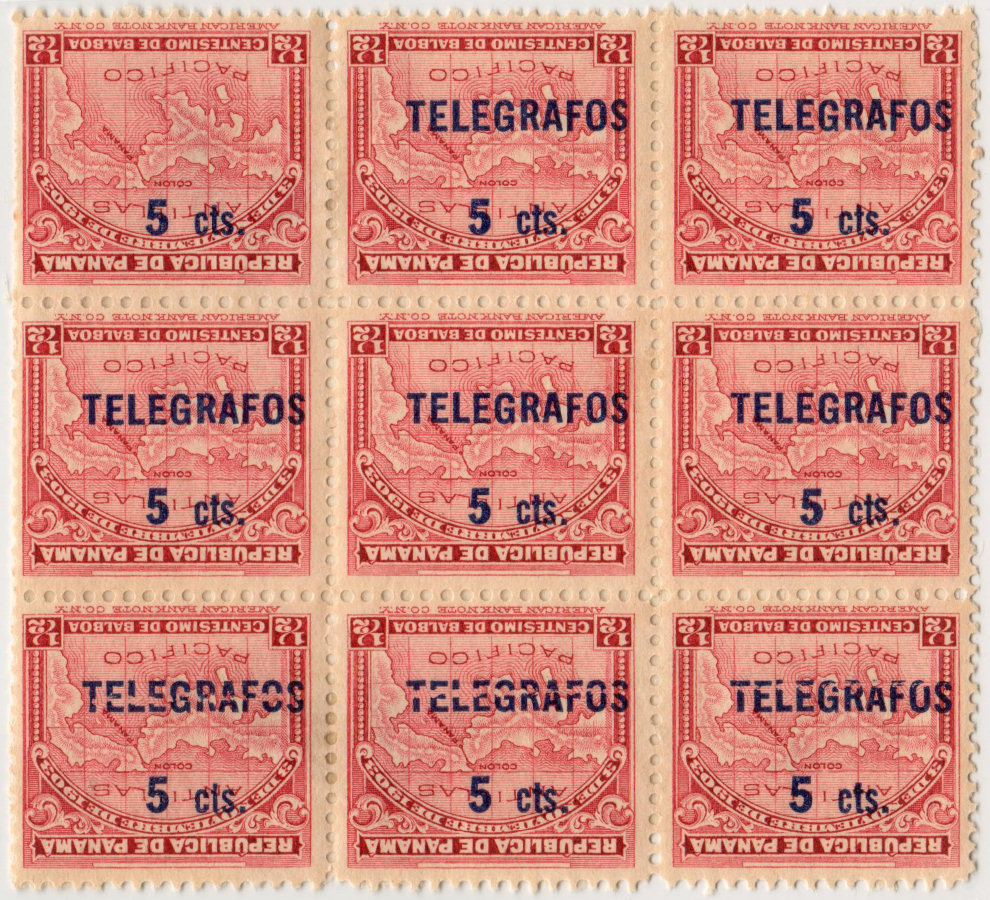
The bottom row has a line of damage through all of the "TELEGRAFOS".
Image courtesy of Tomáš Šolc.
Examples showing the positions of these errors (click on them for a larger version).

RH11cd (small round dot, and inverted) in strip from the bottom of the sheet.
Overprint position 8 (stamp position 101-8 = 93 due to being inverted). - Image courtesy of Federico Brid.
No sheet imprint at the bottom.

RH11ce (inverted period on inverted overprint) at overprint position 91 in a strip (here on stamp 101-91 = 10).
With sheet imprint at the top. Image courtesy of Federico Brid.
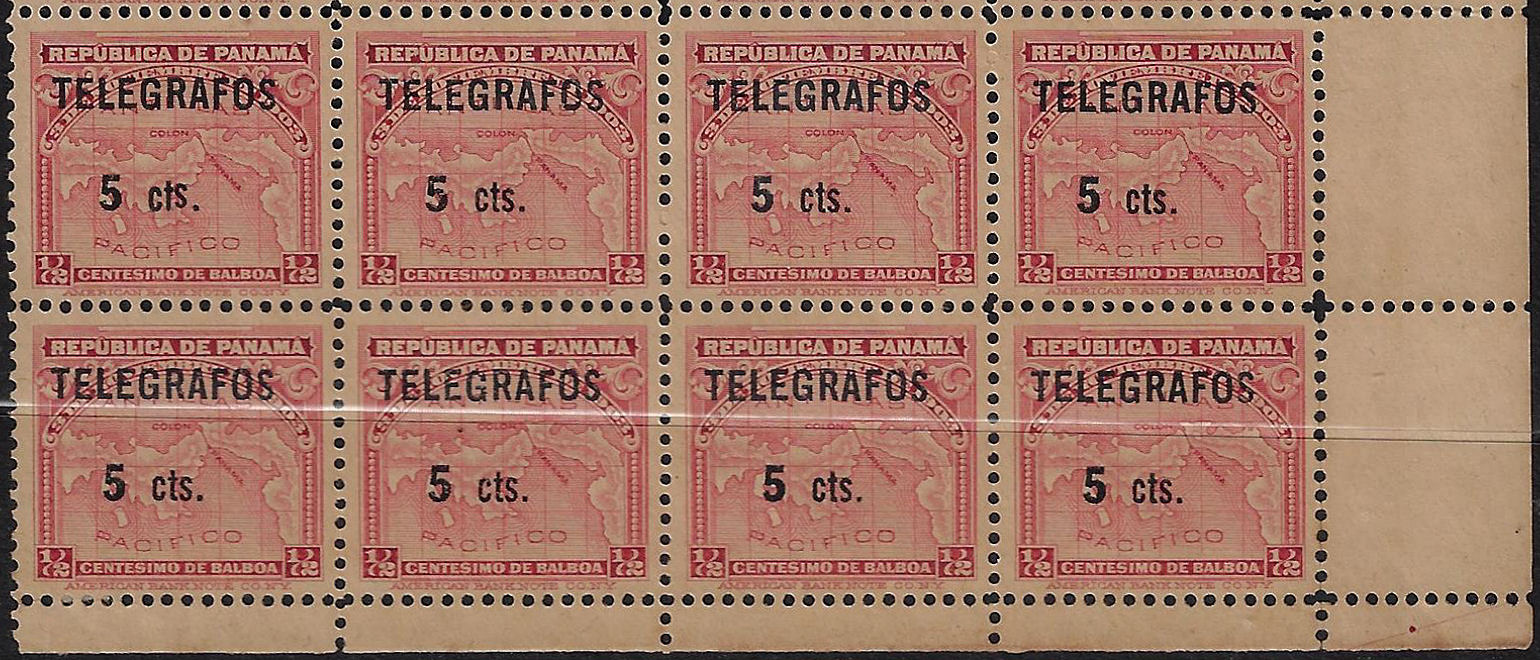
RH11f (raised "s" in "cts.") at position 87 in a block. - Image courtesy of Federico Brid.
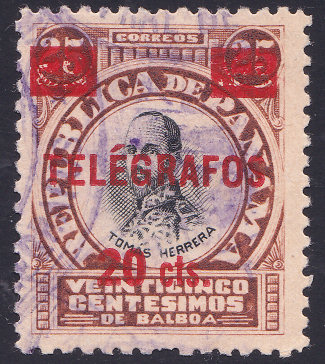 |
 |
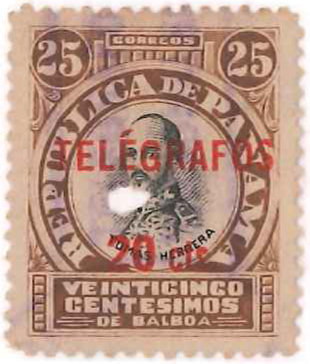 |
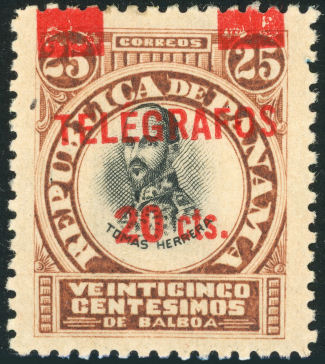 |
| RH12 (Accent on 'É'). Average used, one of mine. |
RH12a - overprint double Courtesy of Nik Oquist |
RH12b - red blocks missing Courtesy of Federico Brid. |
RH12c - overprint slanted. Courtesy of Nik Oquist |
 |
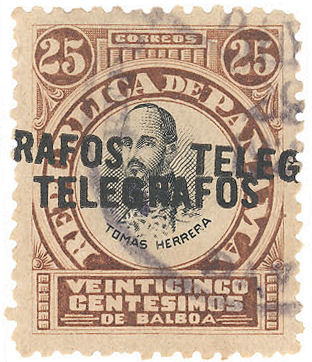 |
| *RH13 (No accent on 'É') | *RH13a Courtesy of Federico Brid. |
1919 Revenue stamps of 1917 (?) overprinted 'TELEGRAFOS' in black or red. White wove paper. No watermark. Perf. 12
These were authorized by Decree 191 of 13 December 1917 to be valid immediately.
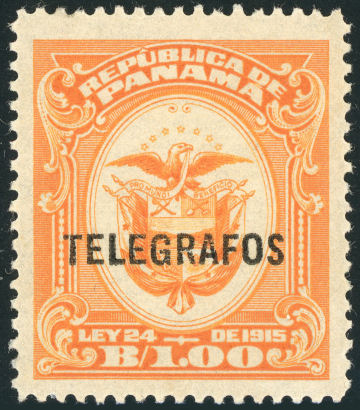 |
 |
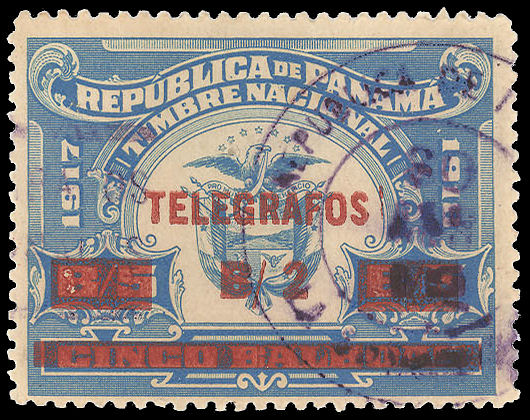 |
 |
| RH14 courtesy of Nik Oquist. | RH14 punched from Wiki-Commons. | RH15 kindly supplied by Brid and Ross. | RH16 kindly supplied by Rolf Lamprecht |
| RH # | Hisc. | BR# | Type. | Description | Mint | Used |
|---|---|---|---|---|---|---|
| RH14 | H12 | 15 | 10 | 1B brownish orange (overprint in black) | 40.00 | 15.00 |
| RH15 | H13 | 16 | 11 | 2B on 5B blue (overprint in red) | 50.00 | 30.00 |
| RH16 | H14 | 17 | 12 | 5B blue (overprint in red) | 100.00 | 75.00 |
Hiscocks added the following note:
| Note. The last Forbin catalogue was published in 1915 and it is not therefore possible to give Forbin references. I am aware of no later catalogue covering Panamanian revenue stamps. |
Decree 115 of 20 May 1919 changed the tariff for telegraph fees from 10th of June.
20c for the first 10 words or less, including the address and signature.
1c for each additional word. There were revisions to additional charges.
Telegrams in foreign languages would be accepted as long as they were in roman characters and legible.
1919 Postage stamps of 1909-17 (SG152, 157) overprinted as above (10). White wove paper. No watermark. Perf. 12.
Printed by American Bank Note Co. N.Y.
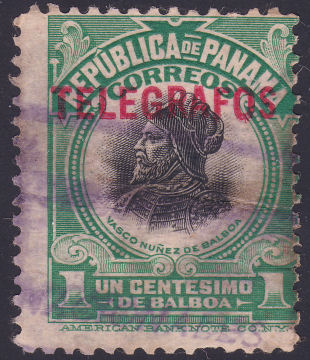 |
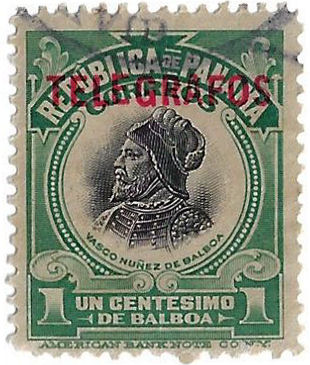 |
 |
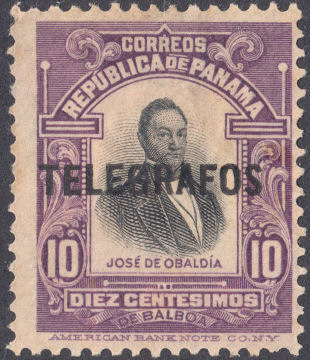 |
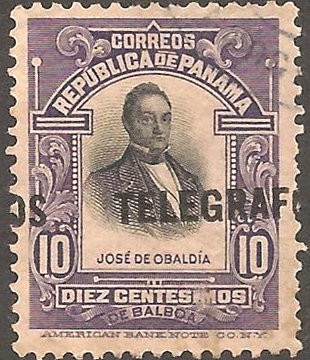 |
| Type 13 - RH17 | Type 13 - RH17b Courtesy of Federico Brid |
Type 13 - RH18 | Type 14 - RH19 - overprints can be quite badly shifted. | |
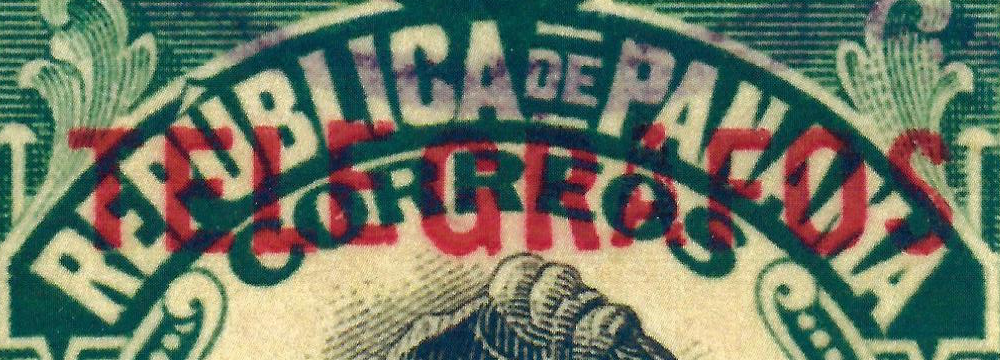
RH17b detail, courtesy of Federico Brid. The second 'E' is also raised slightly.
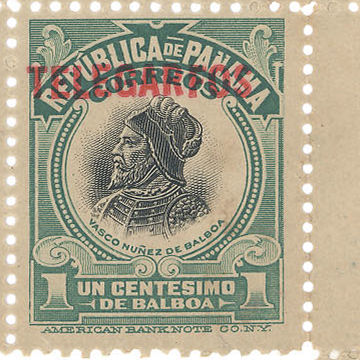 |
 |
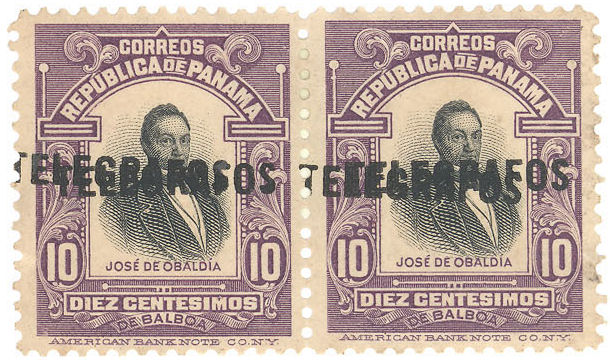 |
| Type 13 - RH17a | Type 13 - RH17c | Type 14 - RH19a |
| The red overprint is noticeably higher on the stamp than the black ones. - Images courtesy of Federico Brid | ||
| RH # | Hisc. | BR# | Type. | Description | Mint | Used |
|---|---|---|---|---|---|---|
| RH17 | H15 | 18 | (13), (10) | 1c green and black (overprint in red) | 12.00 | 2.00 |
| RH17a | H15a | 18a | error — 'TELEGARFOS' (last stamp in sheet of 100) | 30.00 | 25.00 | |
| RH17b | - | - | error — dropped 'GR' in 'TELEGRAFOS' | 30.00 | 25.00 | |
| RH17c | - | 18b | overprint double | 25.00 | 20.00 | |
| RH18 | H15 | 19 | (13), (10) | 1c green and black (overprint in black) | 12.00 | 2.00 |
| RH19 | H16 | 20 | (14), (10) | 10c violet and black (overprint in black) | 10.00 | 2.00 |
| RH19a | H16a | 20a | overprint double | 25.00 | 20.00 |
1919-1921 New design. White wove paper. No watermark. Perf. 12.
Printed by American Bank Note Co. N.Y.
8 of these were issued 10 June 1919 (by decree of 28 May 1919). The 20c was issued in 1921 (January 25, sheets of 200 with central gutter).
For some reason, the 20c has a frame about 0.51mm taller and 0.72mm wider than the 50c
and the imprint is bigger (yes I did physically check). The 1B and 5B are intermediate.
David Zemer tells me that this is due to the American Bank Note Company migrating from
flat plate printing to rotary press in this period (see flat-vs-rotary).
| RH # | Hisc. | BR# | Type. | Description | Mint | Used |
|---|---|---|---|---|---|---|
| RH20 | H17 | 21 | 15 | ½c orange | 4.00 | 8.00 |
| RH21 | H18 | 22 | 15 | 1c deep green | 4.00 | 4.00 |
| RH22 | H19 | 23 | 15 | 5c indigo | 4.00 | 4.00 |
| RH23 | H20 | 24 | 15 | 10c deep reddish violet | 4.00 | 4.00 |
| RH24 | H21 | 25 | 15 | 20c lake-brown (1921) | 3.00 | 2.00 |
| RH25 | H22 | 26 | 15 | 25c carmine-red | 4.00 | 2.00 |
| RH26 | H23 | 27 | 15 | 50c deep brown | 6.00 | 3.00 |
| RH27 | H24 | 28 | 16 | 1B blue-black | 12.00 | 8.00 |
| RH28 | H25 | 29 | 16 | 5B olive-black | 30.00 | 10.00 |
For each of these, specimens with round punch holes of about 2.5mm diameter (add subscript a), imperforate plate proofs on card (add subscript b) are known.
There are also die proofs on India paper mounted on card for all of them and a colour trial proof known of the 50c in green.
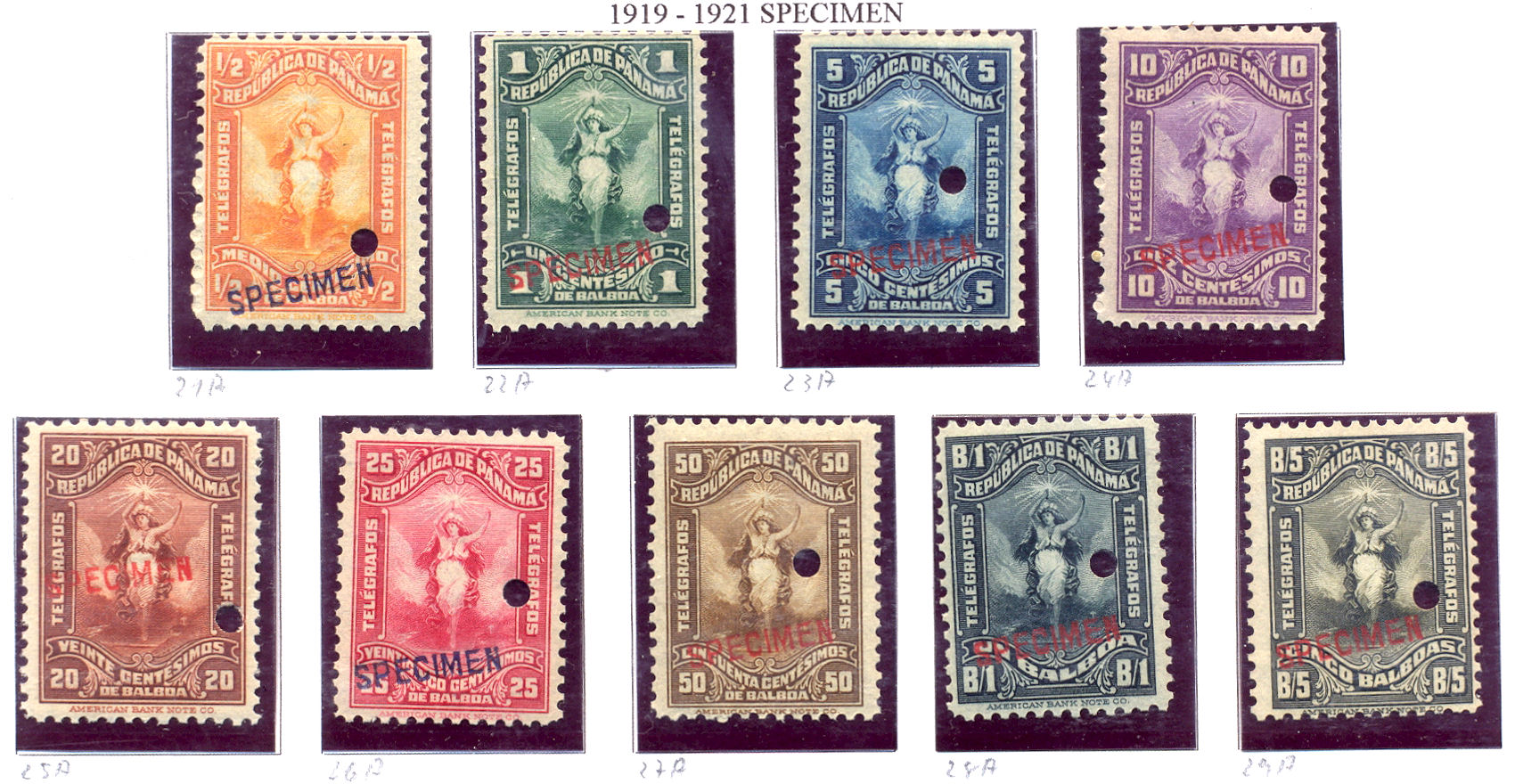
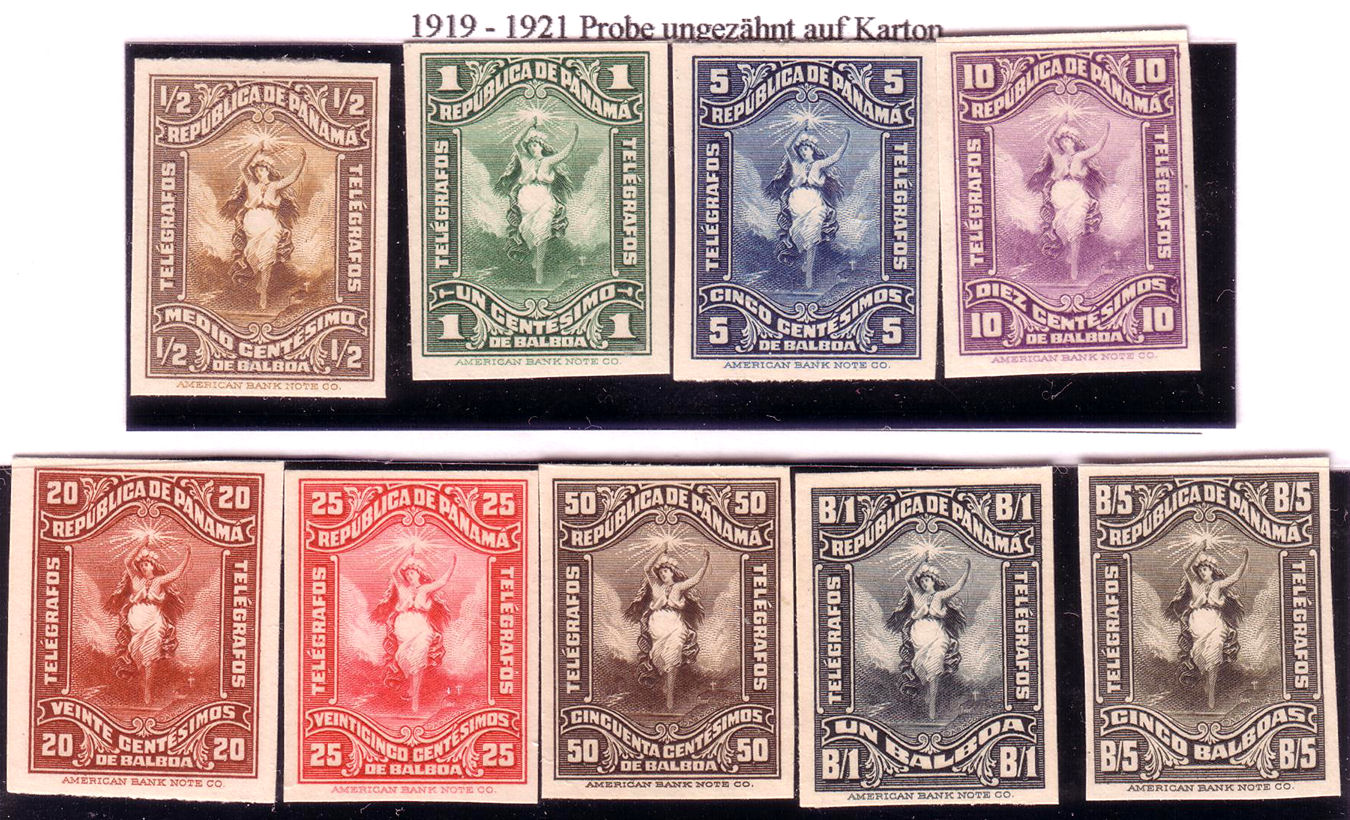
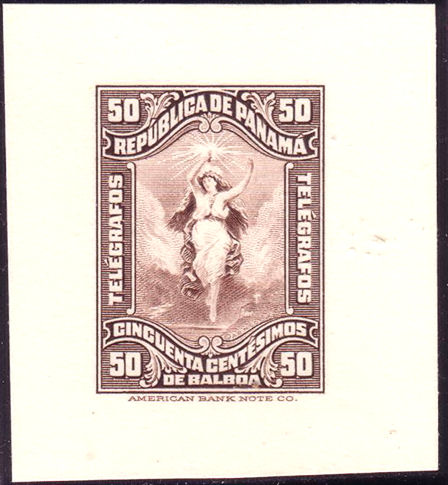
Examples courtesy of Rolf Lamprecht.
Decree 165 of 27 October 1920 modified decree 115 above to allow medical-related telegraph and telephone service fees at half price.
This would seem to be the first requirement for a ½c stamp.
1924-1934 Postage stamps of 1915-21 (SG 161 etc.) overprinted as indicated in black, red or purple.
Stamps have black designs surrounded by coloured frames. White wove paper. No watermark. Perf. 12.
These were to implement the 9th law of 1924.
The law was intended to provide extra salary for telegraph employees with over 5 years service and fund a pension for those with more than 20 years service.
It also provided some incapacity benefits.
Updated images of the overprints created using RetroReveal.org
Hiscocks added the following note:
| Note. The overprint on No. 26 omits the bottom line of 19 since the value is unchanged. |
Decree 205 of 7 November 1926 abolished the use of telegraph stamps to indicate payment of telegraph and telephone use, except for those implementing the 9th law of 1924.
All existing stocks of stamps were to be returned to the Chief Accountant.
1928 (?) - Sheets of 100 printed by the American Bank Note Co.
There are two types of this overprint with different alignments between top and bottom. I am unsure of the relative scarcity, but think about the same.
Federico Brid has designated them as Type I and Type II, so I will adopt the same designations.
Hiscocks was unaware of the two types, his illustration was of a Type II.
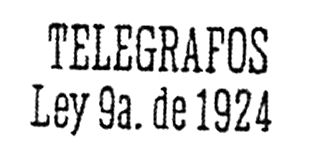 |
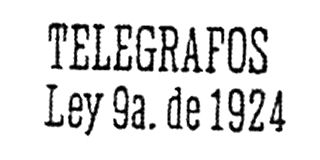 |
| Type I | Type II (as illustrated by Hiscocks) |
On Type I, the bottom line is spaced over to the left, whereas on Type II it is over to the right.
They are not common. My thanks to David Zemer for pointing this out, and Federico Brid for images.
The overprints were made with rubber hand-stamps, so orientation is variable.
Does anyone have clearly dated examples of any of these ?
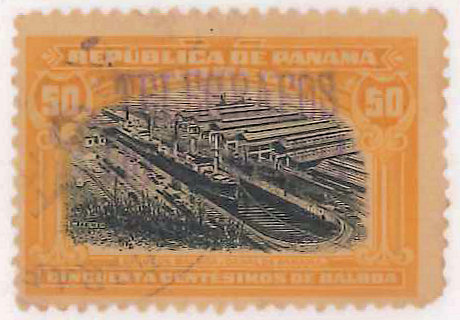 |
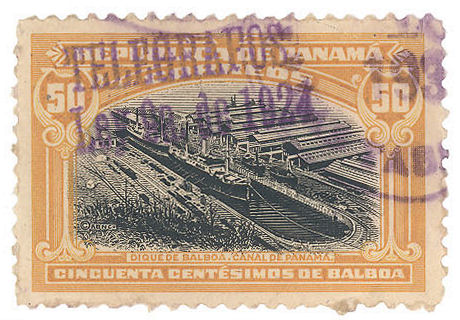 |
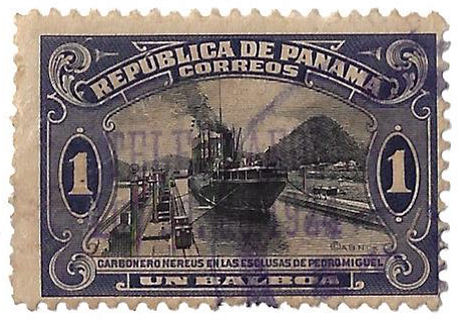 |
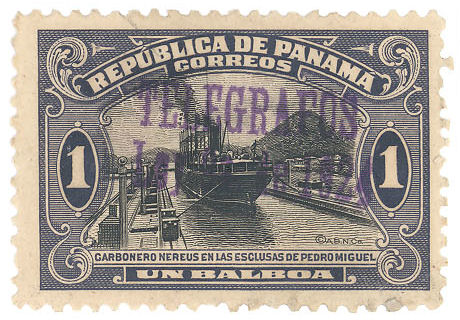 |
| RH32 50c. Type I | RH32a 50c. Type II | RH33 1 B. Type I | RH33a 1 B. Type II |
| Note the ABN Co copyright notices on the ship images rather than imprints. - Images kindly supplied by Federico Brid. | |||
It is unknown when these were issued, though Hiscocks implies 1934. They are surprisingly scarce. The 50c above is clearly dated in the 1930's,
but clearest date known is May 1934 on a 1 Balboa of Rolf Lamprecht.
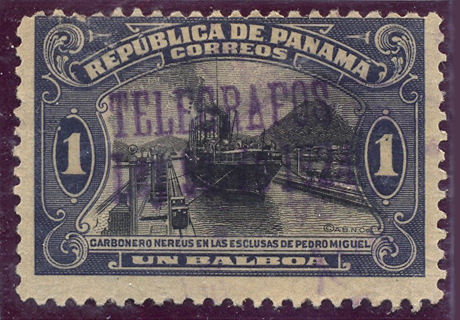

Another example of RH33a courtesy of Rolf Lamprecht, the flaw in the left value tablet may not be constant.
On the right is an inverted RetroReveal.org image of the stamp supplied by David Zemer showing the cds dated in May 1934.
Hiscocks gave the issue dates of H26 to H30 as 1924-1934, but does not state the source of that information. Similarly he
supplied dates for H33 to H35, apparently without knowing about the decree 205 of November 1926 that abolished telegraph stamps.
The bibliography of the Federico Brid and Joe Ross Catalog of 2000 lists Steve Hiscocks as a source.
| RH # | Hisc. | BR# | Type. | Description | Mint | Used |
|---|---|---|---|---|---|---|
| RH32 | - | 33 | (21) | 50c yellow-orange and black (SG 181) purple Type I overprint | 50.00 | 30.00 |
| RH32a | H29 | - | 21 | Type II overprint | 50.00 | 30.00 |
| RH33 | - | 34 | (21) | 1B deep violet and black (SG 182) purple Type I overprint | 60.00 | 40.00 |
| RH33a | H30 | - | 21 | Type II overprint | 60.00 | 40.00 |
Law number 111 of 29 December 1928 Decreed that the 2½c set by the 9th law of 1924 be increased to 5c.
1929 (1 January) As above.
Stamps have black designs surrounded by coloured frames. White wove paper. No watermark. Perf. 12.
Sheets of 100.
 |
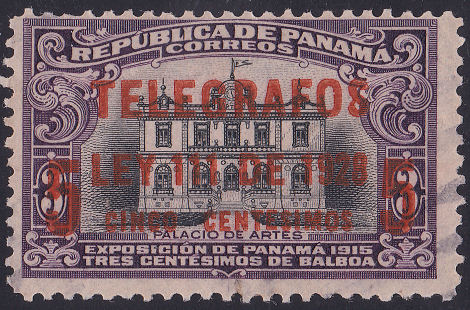 |
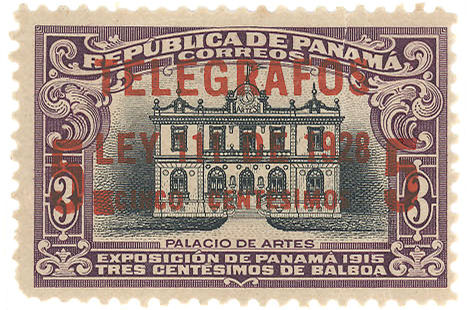 |
| Type 18 with Type 23 red overprint, RH34. | Type 18 with Type 23 vermilion overprint, RH34b. | *RH34ab (with square plug) courtesy of Federico Brid. |
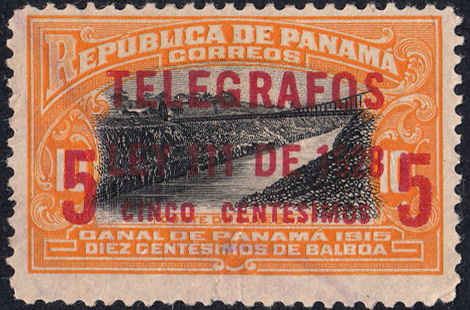 |
 |
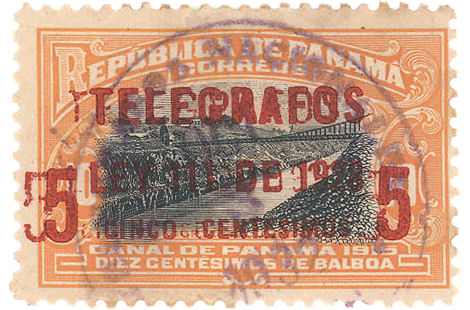 |
| Type 22 with Type 23 red overprint, RH35. | Type 23. | *RH35a (overprint double) courtesy of Federico Brid. |
1934 Postage stamp of 1909-17 (American Bank Note Co. N.Y., SG 153) overprinted 'TELEGRAFOS' as type 3 in black.
I have to question this date (derived from Hiscocks' book), since telegraph stamps were abolished November 1926.
I suspect that these simply replaced RH4 when the supply of 1906 stamps ran out, perhaps about 1920?
Then again, perhaps their use was the result of a mistake.
Does anyone have used examples with dates that may be legible on them ?
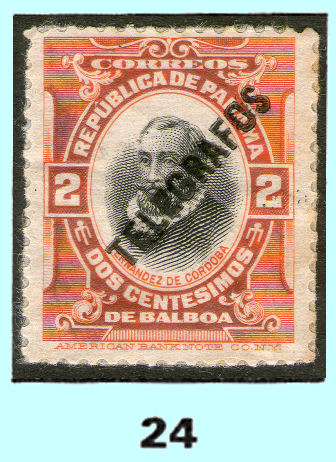
RH36
| RH # | Hisc. | BR# | Type. | Description | Mint | Used |
|---|---|---|---|---|---|---|
| RH36 | H33 | 37 | (24), 3 | 2c vermilion and black | 7.50 | 5.00 |
1935 N0. 20 overprinted as type 25 in red.
Does anyone have used examples with dates that may be legible on them ?
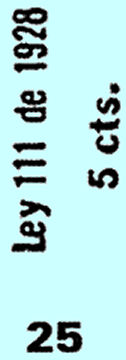 |
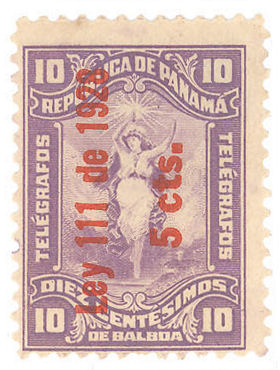 |
| Type 25 on Type 15, RH37 |
Type 25 Image taken from Hiscocks book page 237. RH37 image courtesy of Federico Brid.
| RH # | Hisc. | BR# | Type. | Description | Mint | Used |
|---|---|---|---|---|---|---|
| RH37 | H34 | 38 | 15, 25 | 5c on 10c deep reddish violet | 7.00 | 5.00 |
1935? Postage stamp of 1911 (SG 151b) overprinted 'TELÉGRAFOS' as type 26 in dark green. White wove paper. No watermark. Perf. 12.
I have to question this date also (again derived from Hiscocks' book), since telegraph stamps were abolished November 1926.
Instead they may simply have been replacements for RH9 when supplies ran out, or even have been issued alongside RH10.
Does anyone have used examples with dates that may be legible on them ?
Type 26 on Type 8, an update of Hiscocks book page 237.
courtesy of Federico Brid.
| RH # | Hisc. | BR# | Type. | Description | Mint | Used |
|---|---|---|---|---|---|---|
| RH38 | H35 | 39 | 8, 26 | ½c (0.0½B) on ½c carmine | 15.00 | 15.00 |
| RH38a | - | 39a | comma for period (Positions 19-24, 34) | 25.00 | 25.00 | |
| RH38b | - | 39b | "/" after B has top 1mm shorn off (Positions 50, 62, 72, 79, 89) | 25.00 | 25.00 | |
| RH38c | - | 39c | no accent on "E" of "TELÉGRAFOS" (Positions 60, 63) | 37.50 | 37.50 | |
| RH38d | - | 39d | short "/" and no accent on "E" of "TELÉGRAFOS" (Position 86) | 50.00 | 50.00 | |
| RH38e | - | ? | broken "O" in "TELÉGRAFOS" (Position 91) | 50.00 | 50.00 |
This overprint is a modification of the one on RH10 and therefore (probably) has the same flaws.
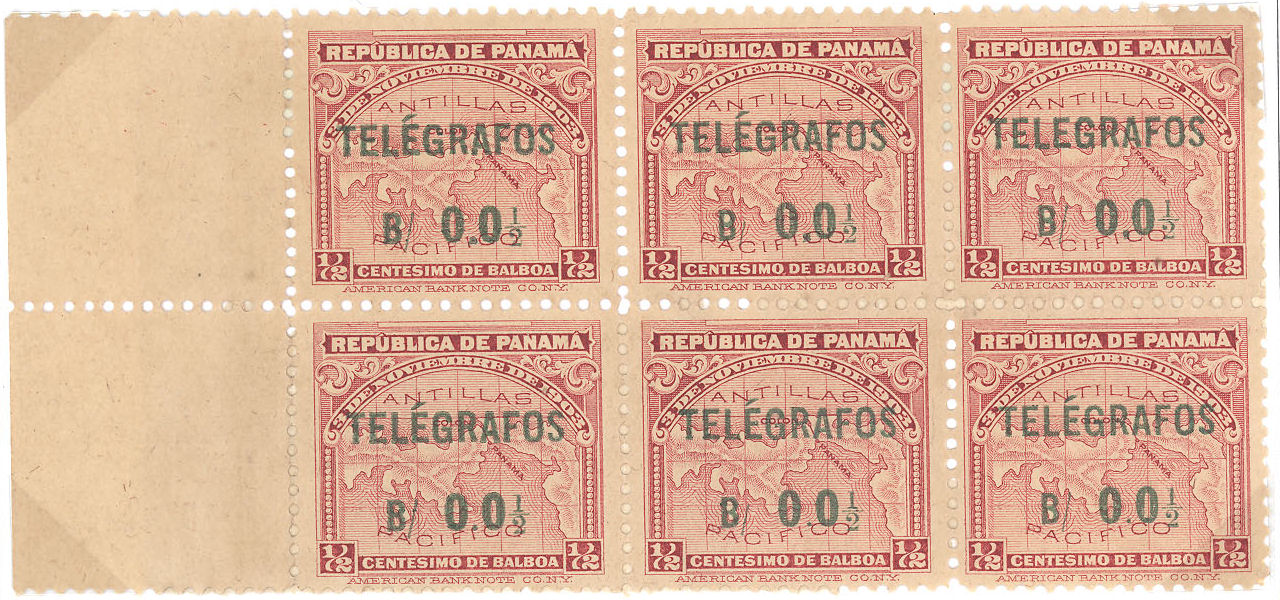
This block shows another missing accent variety, RH38c at position 63. There is also an RH38b (short "/") at position 62, and one below it at 72, though a little longer.
Notice also that the size of the stop is variable. - Image courtesy of Federico Brid.
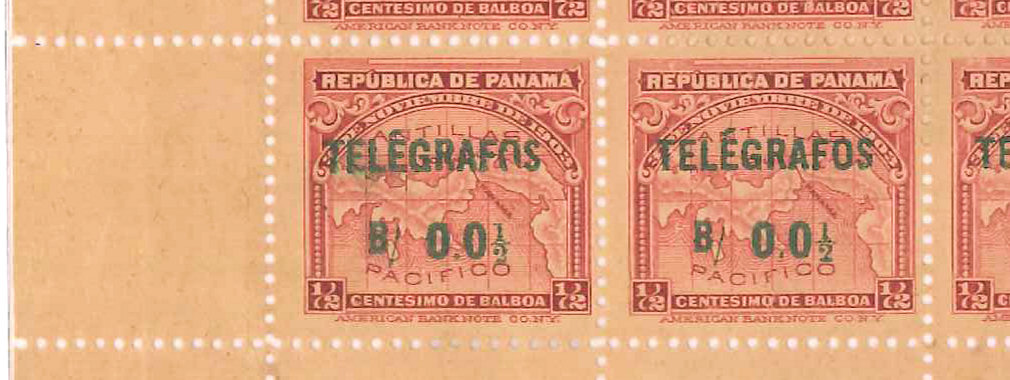
This is part of a block showing the broken "O" variety, RH38e at position 91, with a normal one next to it.
Image courtesy of Federico Brid.
Stationery.
National Telegraph.
Telegrams.
This is an Official Telegram dated 21 August 1904.
It acknowledges the receipt of quentities of revenue paper.

There is no form number, but an imprint reading upwards has "N. Rámos- Panama". Image courtesy of Federico Brid.
Telephone Call Sheets.
This side has Bs64.45 worth of Telegraph stamps cancelled with "OFICINA TELEFONICA / ABR 30 1922 / Santa Rosa
"
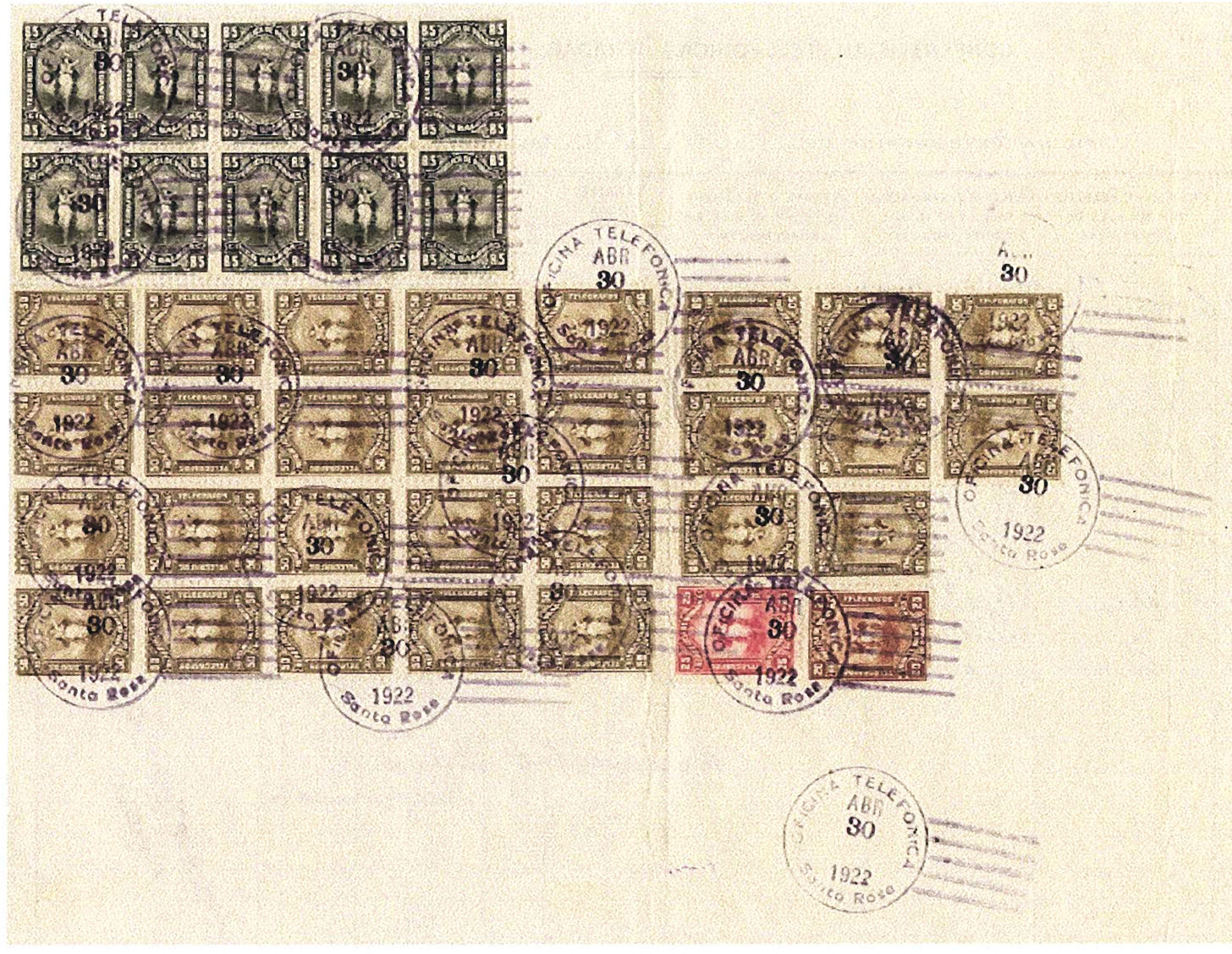
The other side is headed "Conferencias Telefonicas Pedidas Por Esta Oficina" or "Conference Calls Requested By This Office".
Under that it is filled in for Santa Rosa, April 1922. Below that it has columns for :
Date; "Person or Telephone Requesting the Conference"; "Telegraphic Office with which connection is requested"; "Person or Telephone with whom the conference is requested.";
Time, from and to; "Summary in minutes"; Tariff; "Value charged"; "charged to account" and lastly "Person or Company to whom the account is charged".

Charges seem to be for blocks of 3 minutes. This is the last of 3 sheets with the total, Bs49.75 carried over at the top. The grand total at the bottom matches the amount of stamps on the other side.
Agua Dulce appears to be picking up the tab and will presumably recoop it from the customers. This Santa Rosa is in Coclé.
It is signed by the Telephonist. Images courtesy of Federico Brid and Joe Ross.
A similar but later sheet used at the Panama City Office. The year cannot be seen, but must be 1924 or later.
"

This looks like it had at least 40 x 2½c Telegraph stamps.
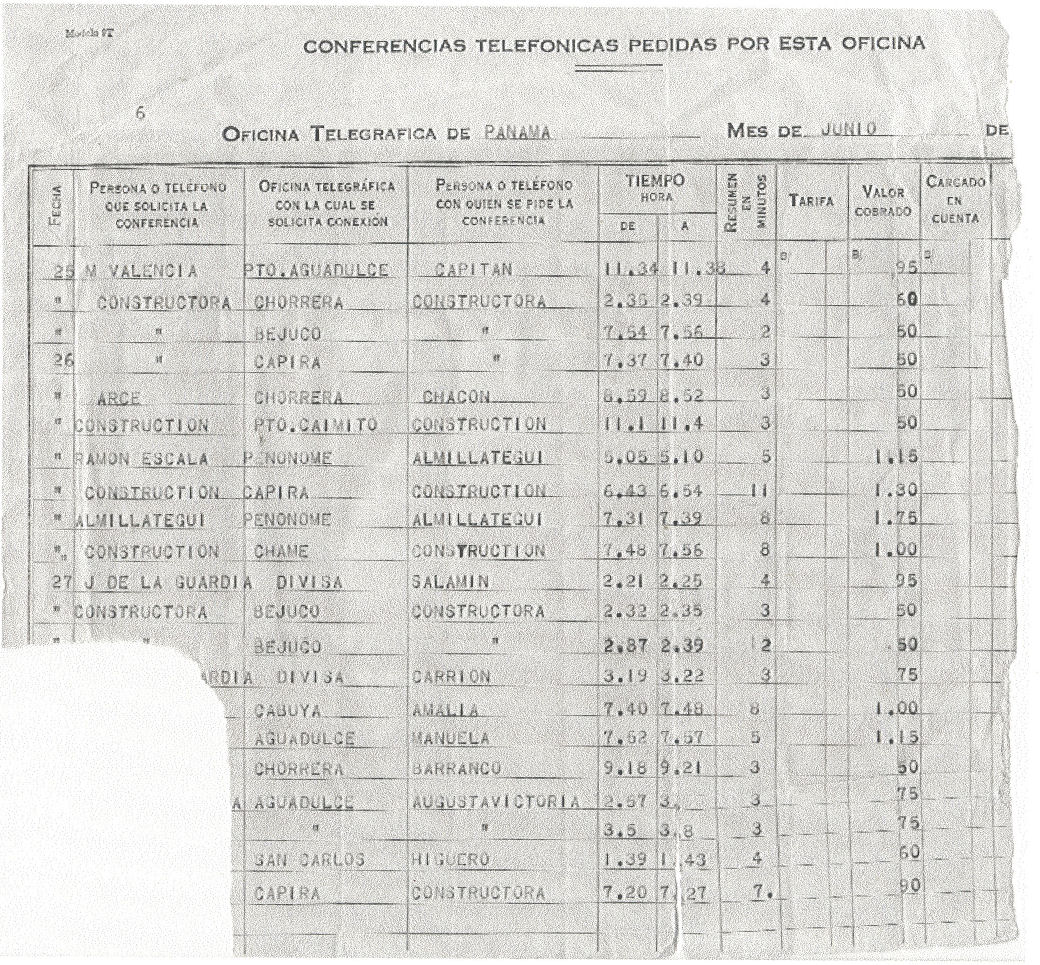
This does not have the Tariffs filled in, but the numbers imply they are not all the same. Images courtesy of Federico Brid and Joe Ross.
A piece of a sheet used at Dolega in September 1929.
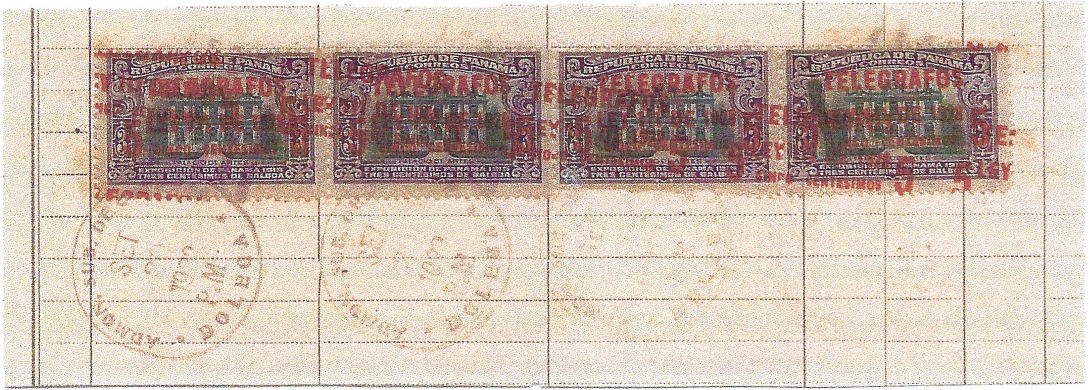
The Telegraph stamps have multiple overprints. Possibly the reason why they were chosen for this purpose. Image courtesy of Federico Brid and Joe Ross.
Another piece of a sheet, this used in December 1929.
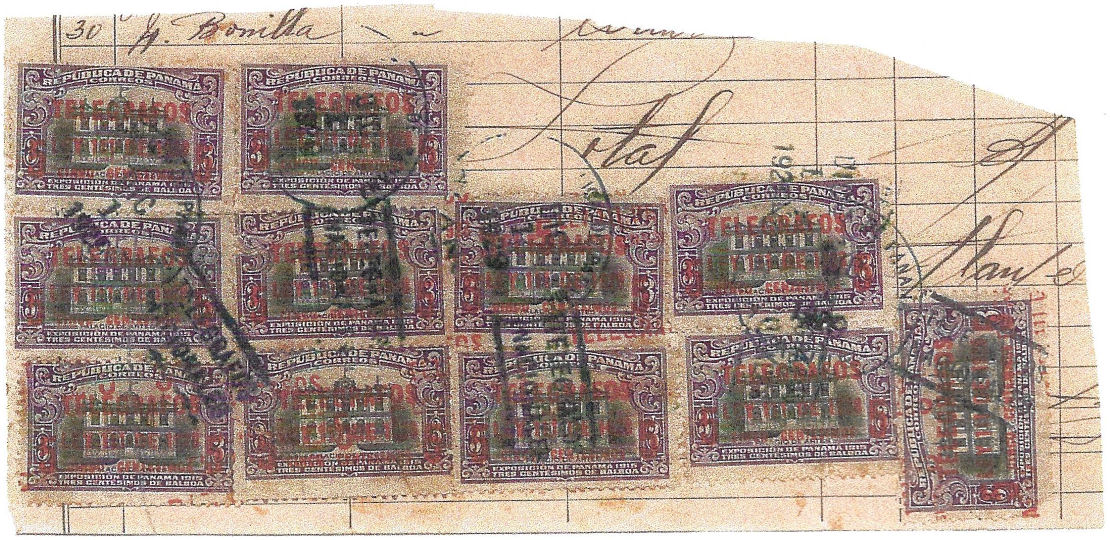
Again at least some of the Telegraph stamps have multiple overprints. Images courtesy of Federico Brid and Joe Ross.
All America Cables, using the Mexican Telegraph Co.
This dated 22 January 1919, with John L. Merrill as President.
This is actually a telegram from Panama, received at New York, but it is likely that telegrams received at Panama would be on similar forms.
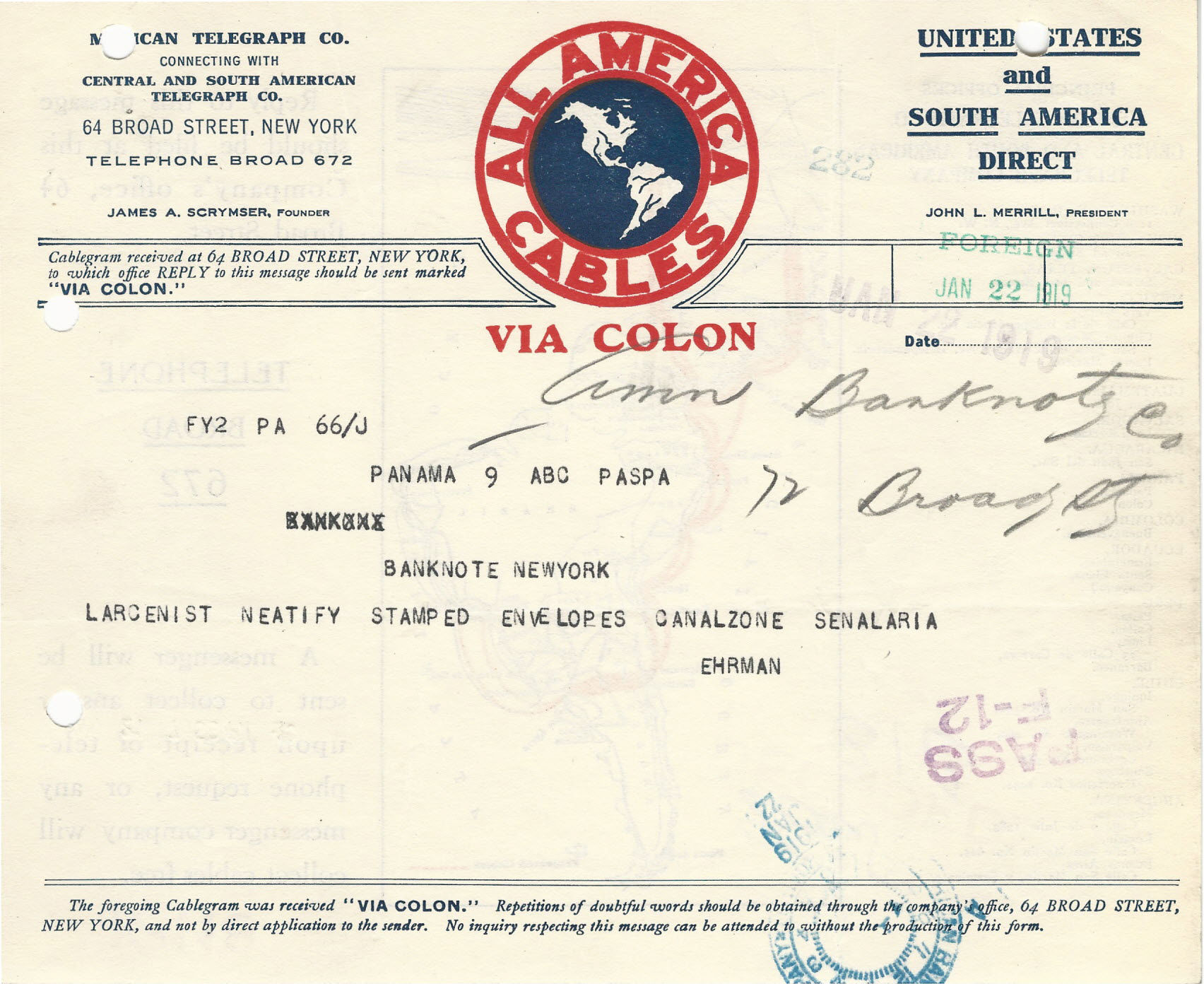
This is from Panama, to the American Bank Note Company of New York, the company printing the Panama postage stamps at the time. It is dated 22 January 1919 and appears to have a map on the back.
Courtesy of David T. Zemer (ABNCo Correspondence collection).
This dated 7 January 1921, with form imprint "S. & C. 200M-9-20" suggesting a printing of September 1920.
This is similar to the last, but with a different Logo Map and revised information on the left. Reference to "Central and South American Telegraph Co" has been dropped, though is still on the receipt !
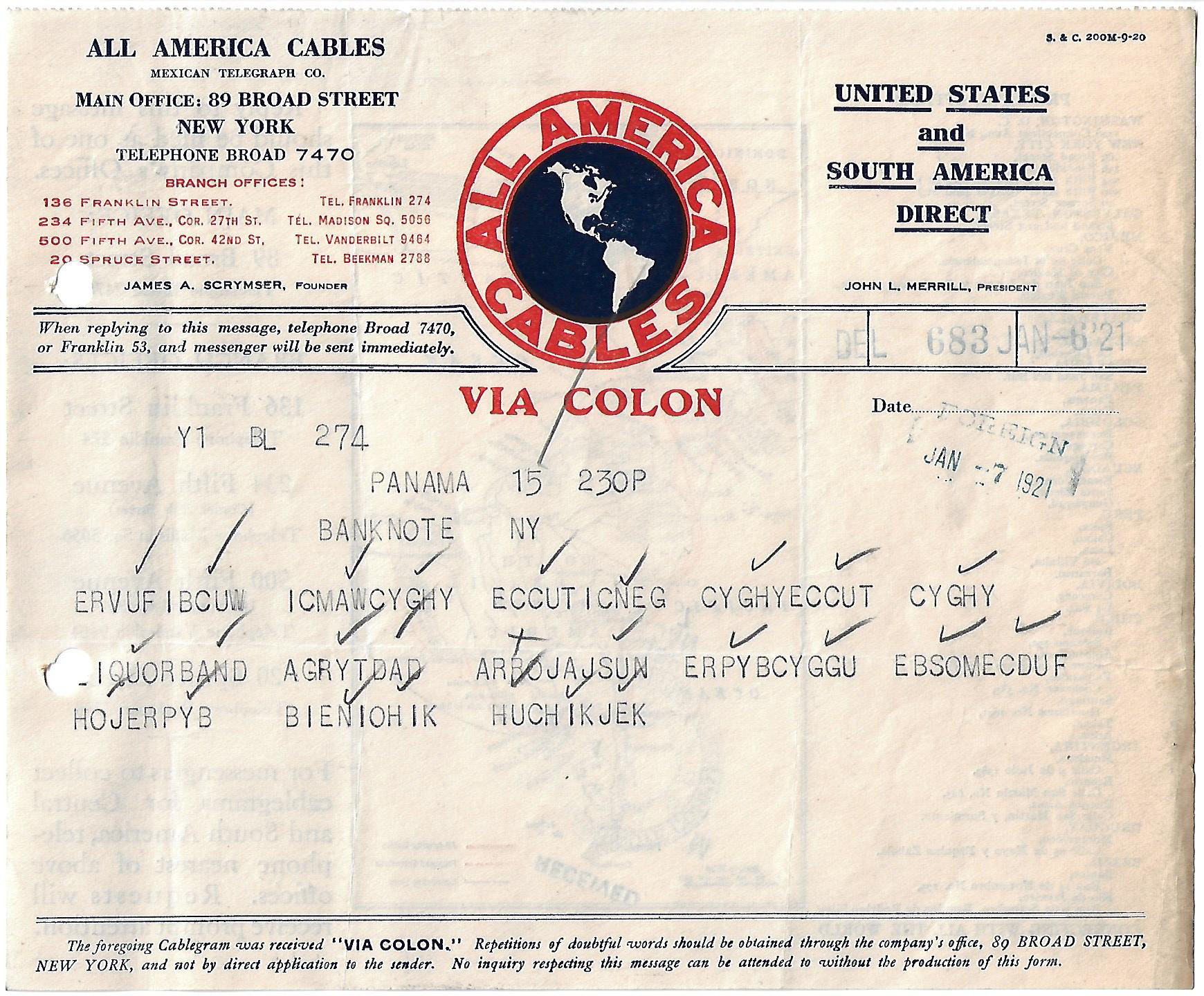
This is also to the American Bank Note Company of New York, received at the Broad Street office, with a map on the back.
Both the extensive list of offices and the map are very informative. It shows the All America Cables lines in red, as well as connecting lines.
Paraguay and Venezuela seem to be ignored, though Venezuela was connected to the French network..
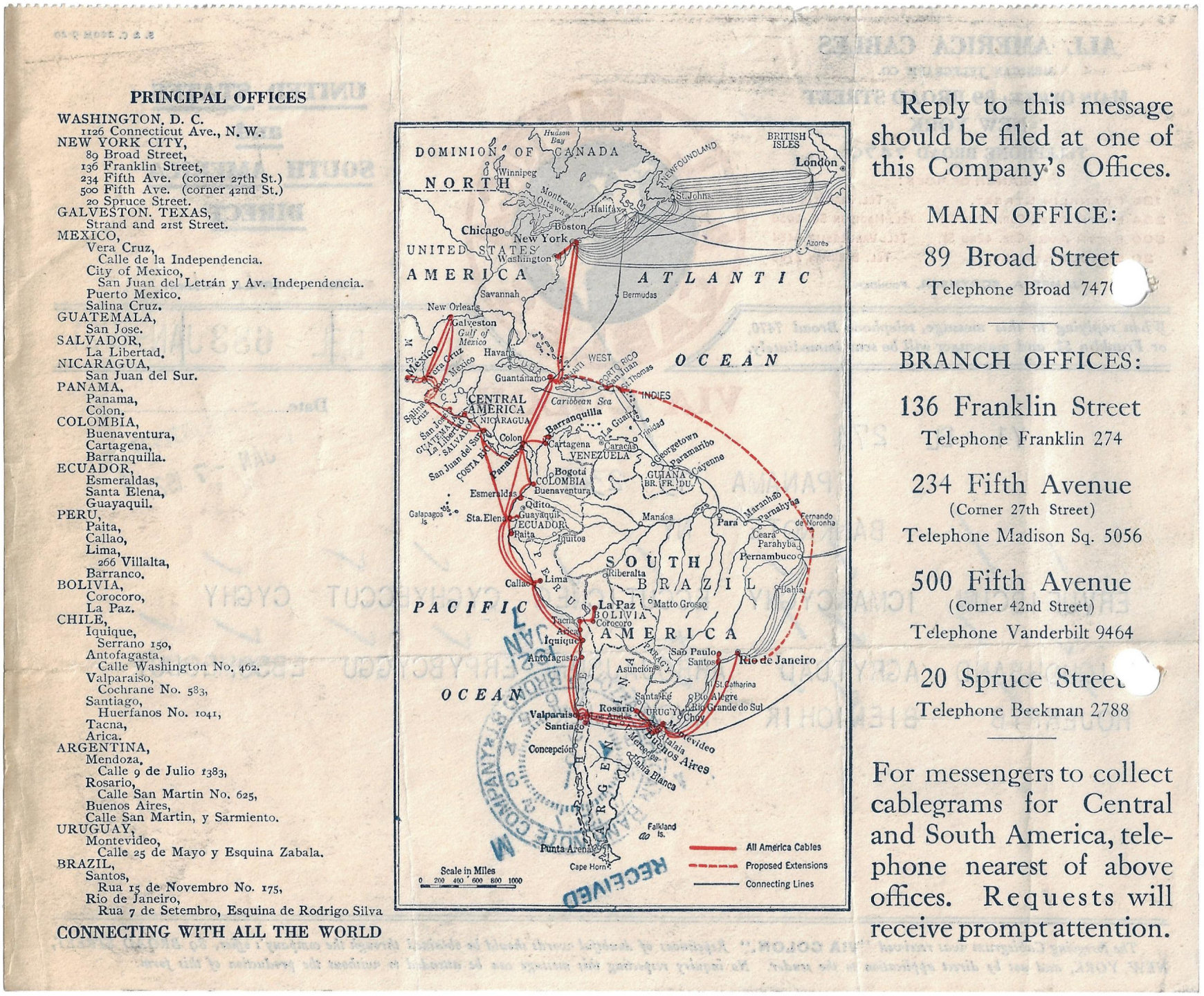
The receipts for sending this telegram are shown below :
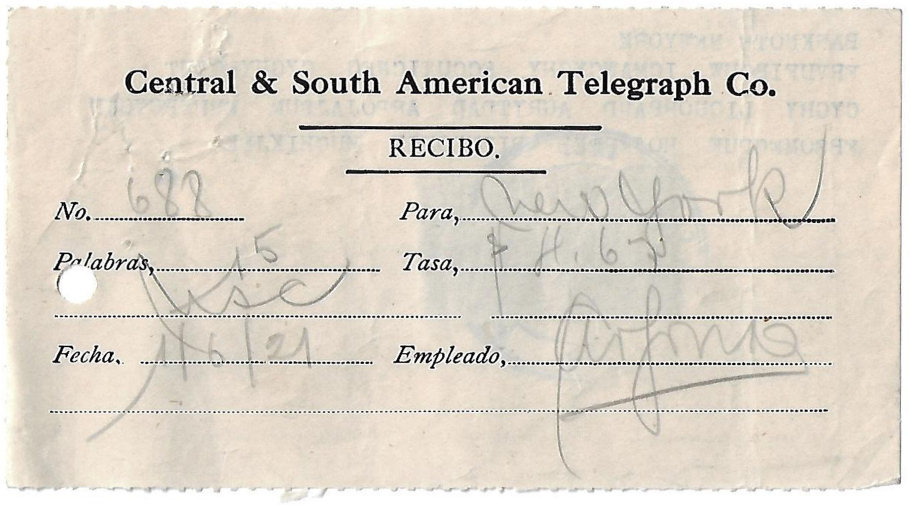
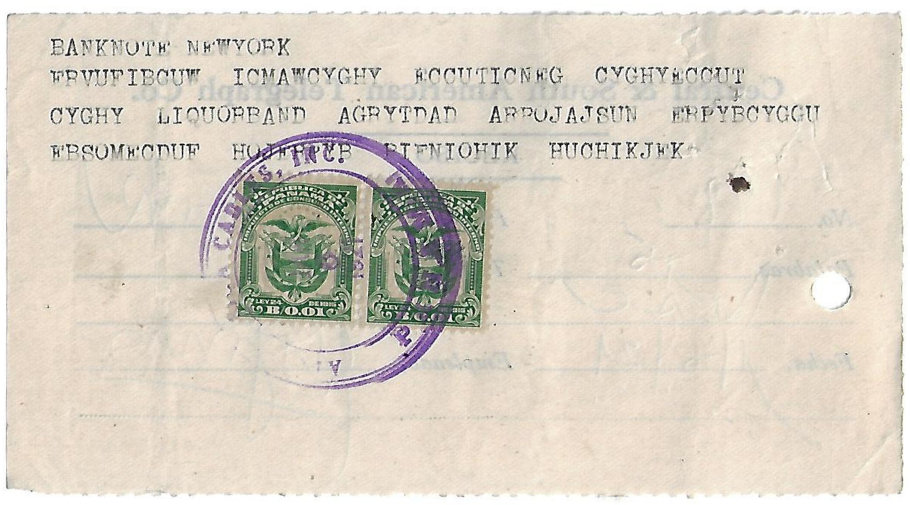
These are Central and South American Telegraph Co. receipts with 2c tax on them. Images courtesy of Federico Brid.
Compañia Telegrafica de Centro y Sud America.
(Central and South American Telegraph Co)
These are headed "Central and South American Telegraph Co." That company had been operating in Panama from 1888 or earlier as seen on Colombian receipts. Then it was "Via Galveston" in Texas.
Delivery Envelopes. (marked in Spanish)
Compañia Telegrafica de Centro y Sud America.
West India and Panama Telegraph Co.
This is headed "West India and Panama Telegraph Co." and was used in Jamaica on 26 November 1906.
Registered to Barranquilla, Colombia.
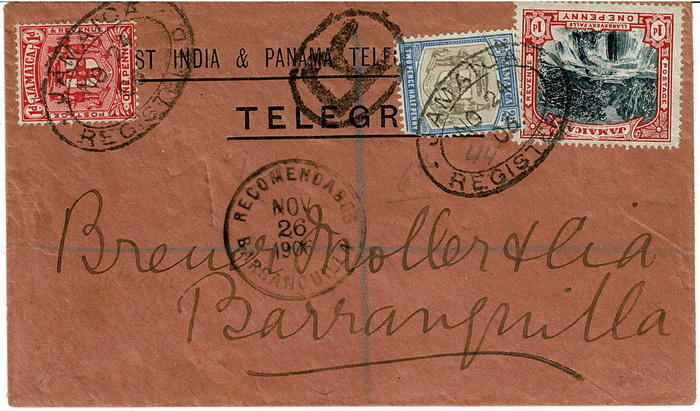
Image courtesy of D.Morrison Ltd.
Receipts.
This is headed "West India and Panama Telegraph Co." This company laid many cables around the Caribbean.
This was for a telegram from Cuba to Ponce on 15 May 1883.
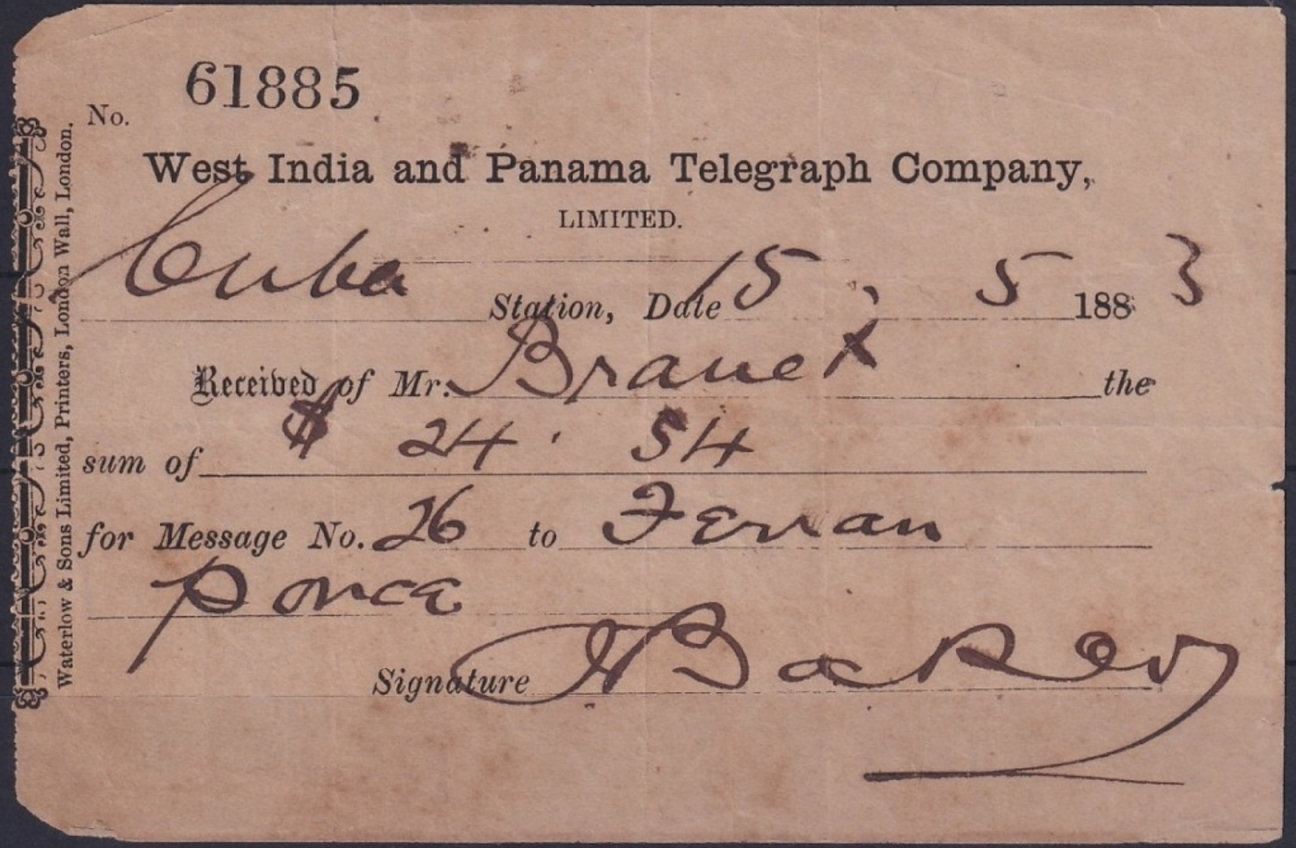
This was printed by Waterlow & Sons of London Wall.
If anyone can provide scans to help, I am happy to give appropriate credit.


